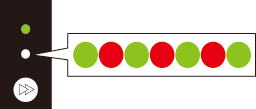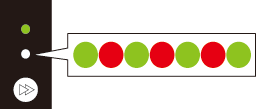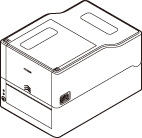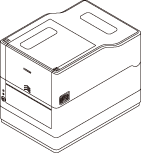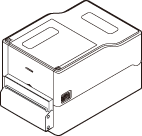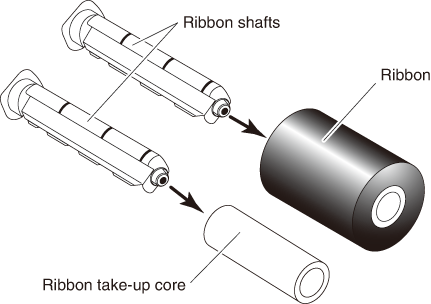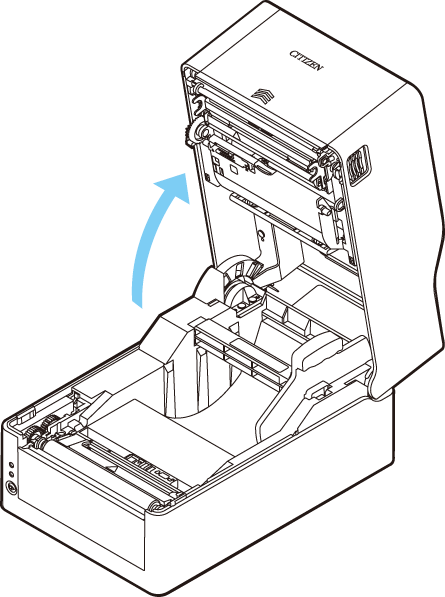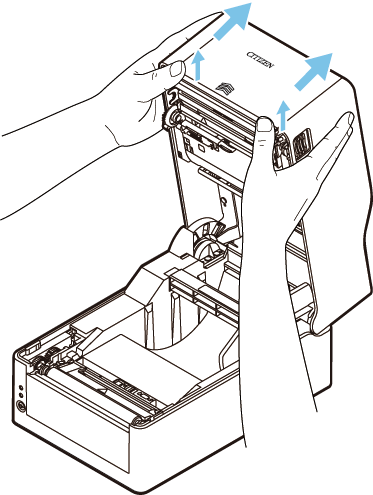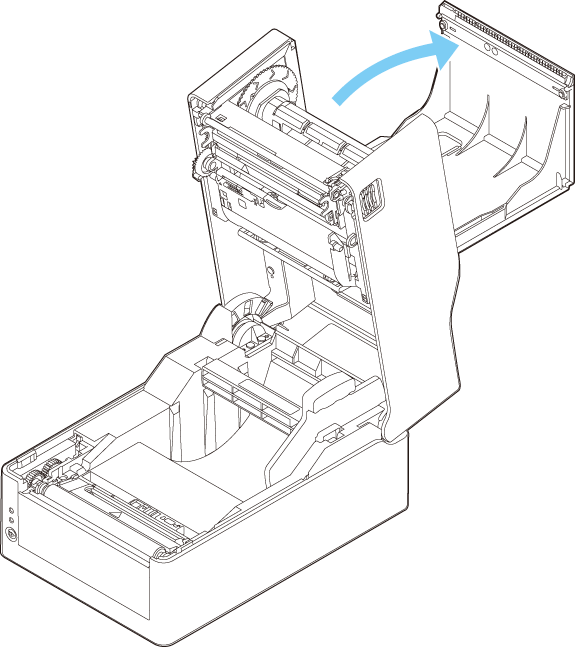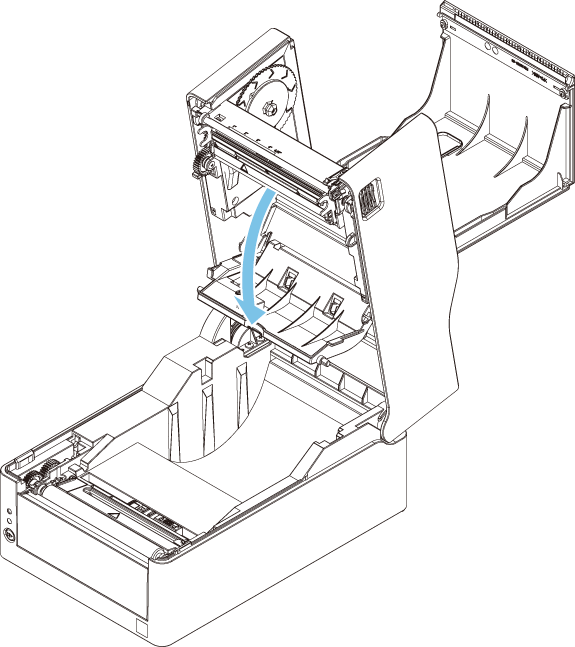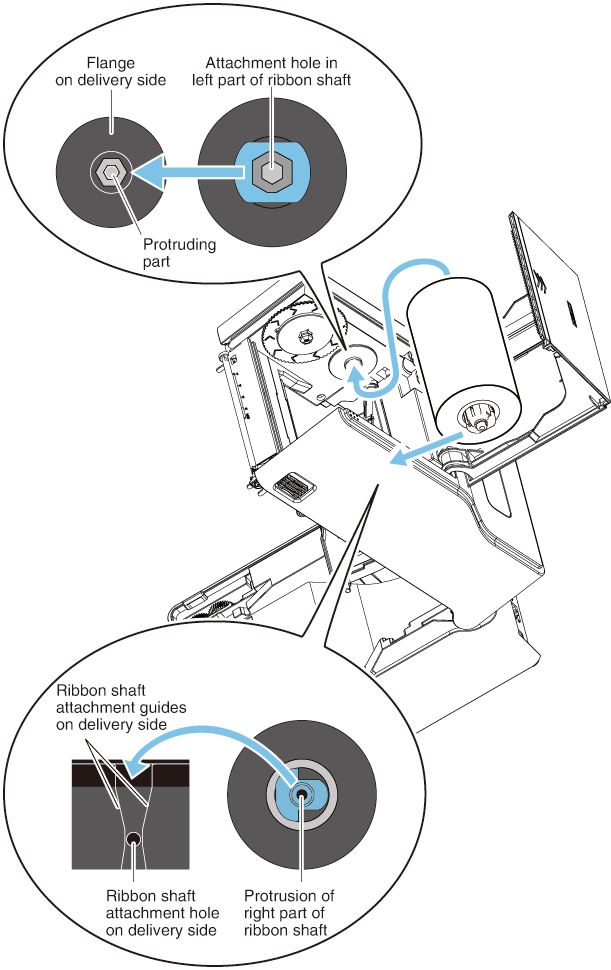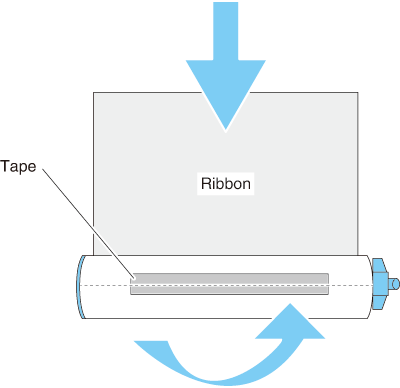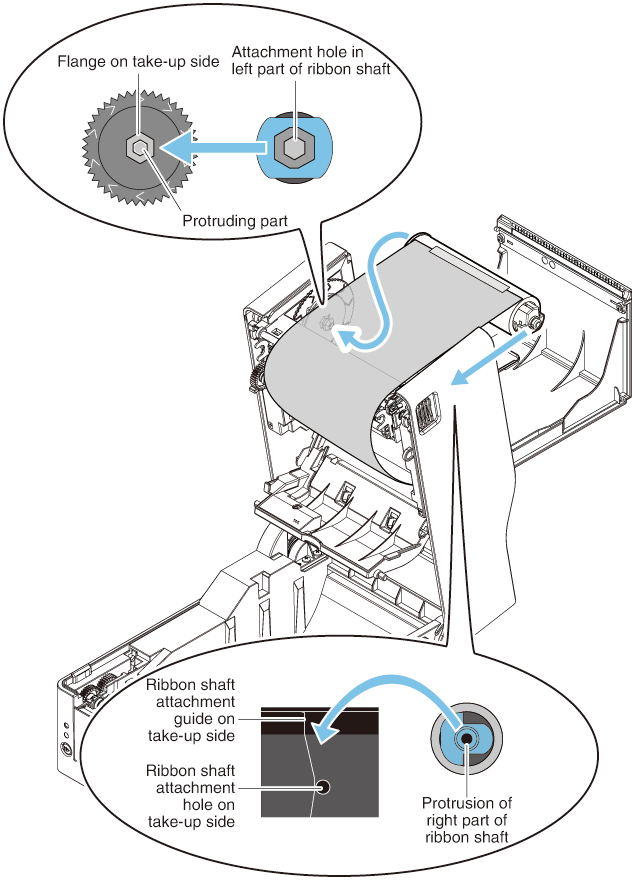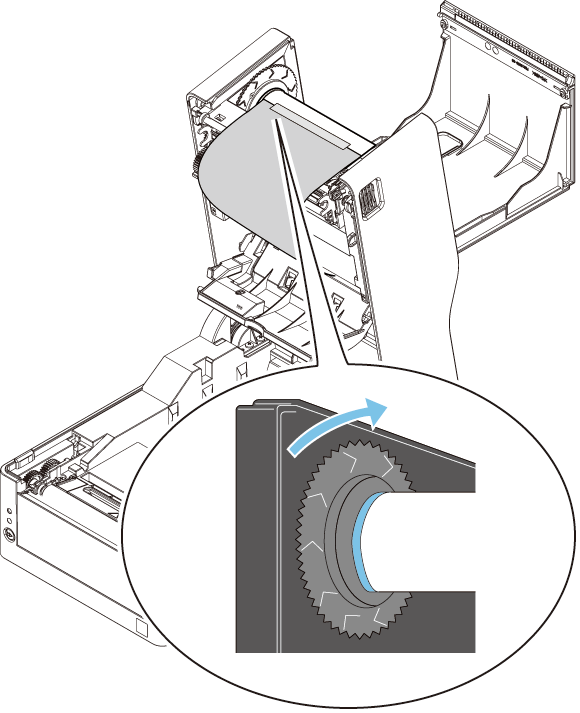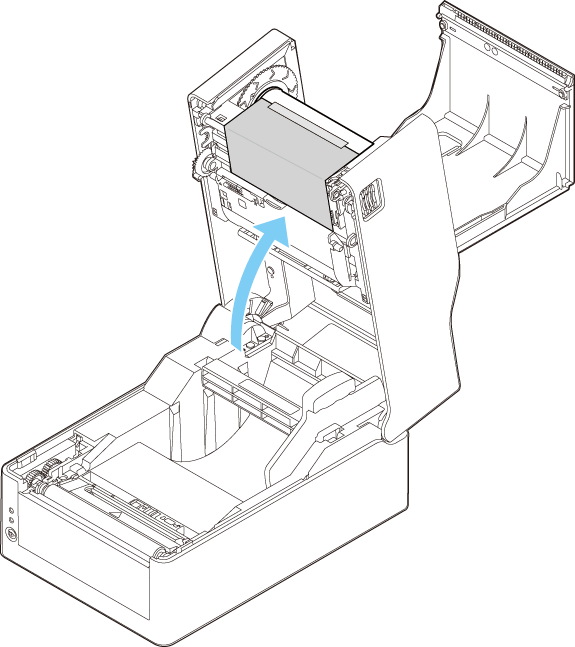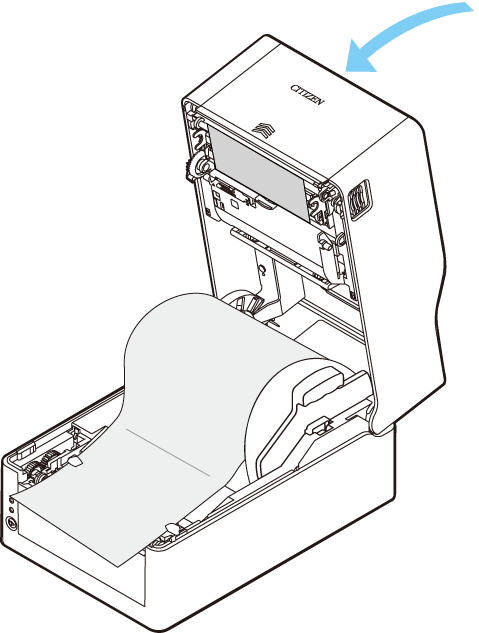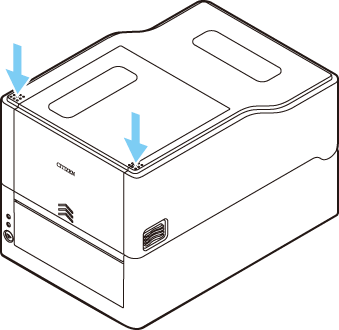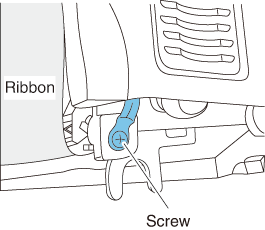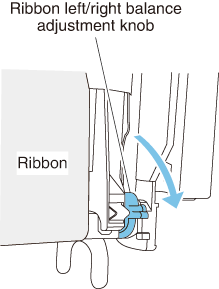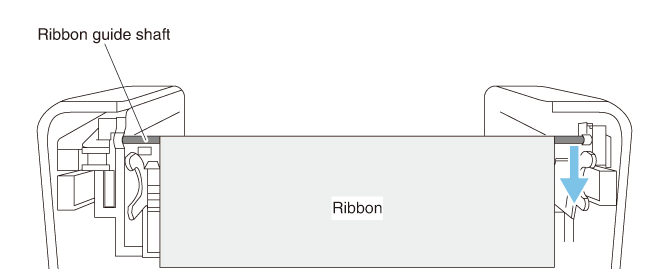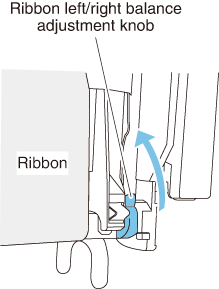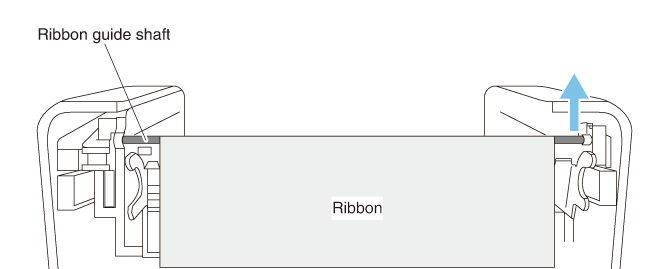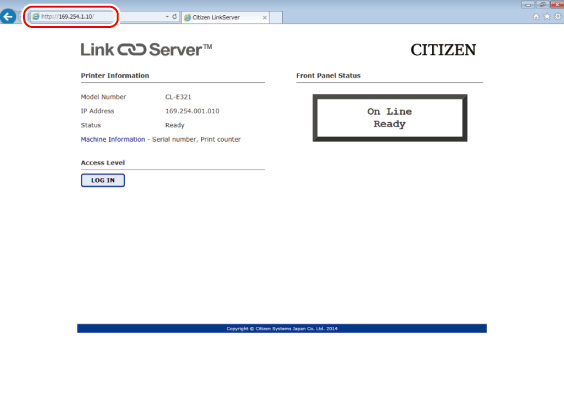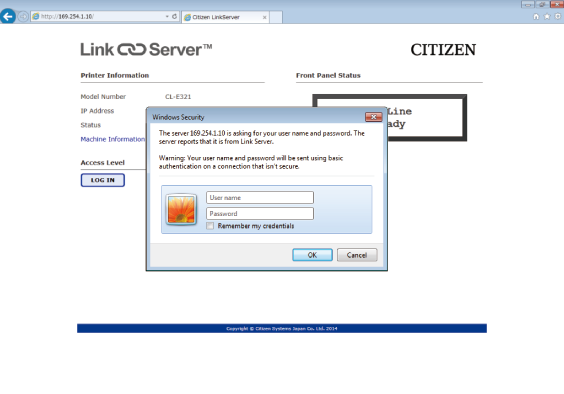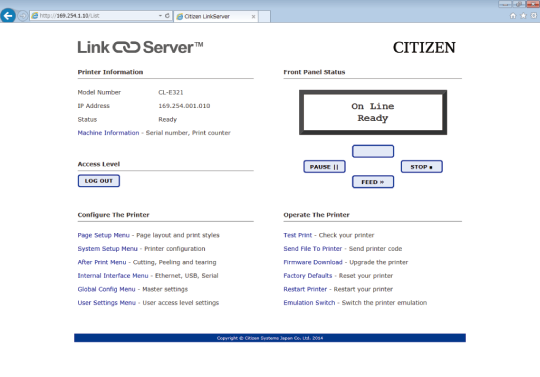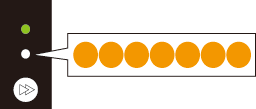LINE THERMAL PRINTER
MODEL CL-E321/CL-E331
User’s Manual
WEEE MARK
 |
If you want to dispose of this product, do not mix it with general household waste.
There is a separate collection systems for used electronics products in accordance
with legislation under the WEEE Directive and is effective only within European Union.
|
 |
Wenn Sie dieses Produkt entsorgen wollen, dann tun Sie dies bitte nicht zusammen mit
dem Haushaltsmüll. Es gibt im Rahmen der WEEE-Direktive innerhalb der Europäischen
Union gesetzliche Bestimmungen für separate Sammelsysteme für gebrauchte elektronische
Geräte und Produkte.
|
 |
Si vous souhaitez vous débarrasser de cet appareil, ne le mettez pas à la poubelle
avec vos ordures ménagères. Il existe un système de récupération distinct pour les
vieux appareils électroniques conformément à la législation WEEE sur le recyclage
des déchets des équipements électriques et électroniques qui est uniquement valable
dans les pays de l’Union européenne.
Les appareils et les machines électriques et électroniques contiennent souvent des
matières dangereuses pour l’homme et l’environnement si vous les utilisez et vous
vous en débarrassez de façon inappropriée.
|
 |
Si desea deshacerse de este producto, no lo mezcle con residuos domésticos de carácter
general. Existe un sistema de recogida selectiva de aparatos electrónicos usados,
según establece la legislación prevista por la sobre residuos de aparatos eléctricos
y electrónicos (RAEE), vigente únicamente en la Unión Europea.
|
 |
Se desiderate gettare via questo prodotto, non mescolatelo ai rifiuti generici di
casa. Esiste un sistema di raccolta separato per i prodotti elettronici usati in conformità
alla legislazione RAEE, valida solo all’interno dell’Unione Europea.
|
 |
Deponeer dit product niet bij het gewone huishoudelijk afval wanneer u het wilt verwijderen.
Er bestaat ingevolge de WEEE-richtlijn een speciaal wettelijk voorgeschreven verzamelsysteem
voor gebruikte elektronische producten, welk alleen geldt binnen de Europese Unie.
|
 |
Hvis du vil skille dig af med dette produkt, må du ikke smide det ud sammen med dit
almindelige husholdningsaffald. Der findes et separat indsamlingssystem for udtjente
elektroniske produkter i overensstemmelse med lovgivningen under WEEE-direktivet,
som kun er gældende i den Europæiske Union.
|
 |
Se quiser deitar fora este produto, não o misture com o lixo comum. De acordo com
a legislação que decorre da Directiva REEE – Resíduos de Equipamentos Eléctricos e
Electrónicos, existe um sistema de recolha separado para os equipamentos electrónicos
fora de uso, em vigor apenas na União Europeia.
|
 |
Jeżeli zamierzasz pozbyć się tego produktu, nie wyrzucaj go razem ze zwykłymi domowymi
odpadkami. Według dyrektywy WEEE obowiązującej w Unii Europejskiej dla używanych produktów
elektronicznych należy stosować oddzielne sposoby utylizacji.
|

Compliance Statement for European Users
|
FCC Compliance Statement for American Users
FCC Related Information
This equipment has been tested and found to comply with the limits for a Class B digital device, pursuant to Part 15 of the FCC Rules.
These limits are designed to provide reasonable protection against harmful interference
in a residential installation. This equipment generates, uses and can radiate radio
frequency energy and, if not installed and used in accordance with the instructions,
may cause harmful interference to radio communications.
However, there is no guarantee that interference will not occur in a particular installation.
If this equipment does cause harmful interference to radio or television reception,
which can be determined by turning the equipment off and on, the user is encouraged
to try to correct the interference by one or more of the following measures:
- Reorient or relocate the receiving antenna.
- Increase the separation between the equipment and receiver.
- Connect the equipment into an outlet on a circuit different from that to which the
receiver is connected.
- Consult the dealer or an experienced radio/TV technician for help.
Pursuant to FCC regulations, you are cautioned that any changes or modifications not
expressly approved in this manual could void your authority to operate this equipment.
|
|
Sicherheitshinweis
Die Steckdose zum Anschluß dieses Druckers muß nahe dem Gerät angebracht und leicht
zugänglich sein.
|
|
EMI Compliance Statement for Canadian Users
This Class B Information Technology Equipment (ITE) complies with Canadian CAN ICES-3(B)/NMB-3(B).
This equipment generates and uses radio frequency energy and if not installed and
used properly, that is, in strict accordance with the manufacturer’s instructions,
may cause interference to radio and television reception. This Information Technology
Equipment (ITE) does not exceed the Class B limits for radio noise emissions from digital apparatus set out in the Radio Interference
Regulations of the Canadian Department of Communications. This equipment is designed
to provide reasonable protection against such interference in a residential installation.
However, there is no guarantee that interference will not occur in a particular installation.
If this equipment does cause interference to radio or television reception, which
can be determined by turning the equipment off and on, the user is encouraged to try
to correct the interference by one or more of the following measures:
- Reorient or relocate the receiving antenna.
- Increase the separation between the equipment and receiver.
- Connect the equipment into an outlet on a circuit different from that to which the
receiver is connected.
- Consult the dealer or an experienced radio/TV technician for help.
État de conformité EMI à l’usage des utilisateurs Canadiens
Cet Équipements informatiques (EI) de la classe B est conforme à la norme CAN ICES-3(B)/NMB-3(B) du Canada.
Cet équipment produit et utilise l’énergie à radiofréquences et s’iln’est pas installé
et utilisé correctment, c’esst à dire en accord strict avec les instructions du fabricant,
il risque de provoquer des intérferences avec la réception de la radio et de latélévision.
Le présent Équipements informatiques (EI) n’émet pas de bruite radio électriques dépassant
les limites applicables aux appareils numériques de la classe B prescrites dans le Réglement sur le brouillage radioélectrique édicté par le ministère
des Communications du Canada.
Cet équipment est conçu pour fournir une protection satisfaisante contre de telles
interférences dans une installation résidentielle.
Cependant, il n’y a pas de garantie contre les interférences avec les réceptions radio
ou télévision, provoquées par la mise en et hors circuit de l’équipment; aussi, il
est demandé a l’utilisateur d’essayer de corriger l’interférence par l’une ou plus
des mesures suivantes:
- Réorienter l’antenne de réception.
- Installer l’ordinateur autre part, par égard pour le récepteur.
- Brancher l’ordinateur dans une prise de courant différente de façon à ce que l’ordinateur
et le récepteur soient branchés sur des circuits différents.
- Consulter le revendeur ou un technicien radio/ TV expérimenté pour toute assistance.
|
GENERAL PRECAUTIONS
- Before using this product, be sure to read through this manual. After having read
this manual, keep it in a safe, readily accessible place for future reference.
- The information contained herein is subject to change without prior notice.
- Reproduction or transfer of part or all of this document in any means is prohibited
without permission from Citizen Systems.
- Note that Citizen Systems is not responsible for any operation results regardless
of omissions, errors, or misprints in this manual.
- Note that Citizen Systems is not responsible for any trouble caused as a result of
using options or consumables that are not specified in this manual.
- Except explained elsewhere in this manual, do not attempt to service, disassemble,
or repair this product.
- Citizen Systems Japan Co., Ltd. shall not be liable for damages caused by improper
or incorrect usage or by the usage environment.
- Data is basically for temporary use and not stored for an extended period of time
or permanently. Please note that Citizen Systems is not responsible for damage or
lost profit resulting from the loss of data caused by accidents, repairs, tests or
other occurrences.
- If you find omissions, errors, or have questions, please contact your Citizen Systems
dealer.
|
- CITIZEN is a registered trademark of Citizen Watch Co., Ltd.
- QR Code is a registered trademark of DENSO WAVE INCORPORATED.
- Datamax® is a registered trademark of Datamax-O'Neil Inc.
- Maxi Code is a registered trademark of UPS.
- Zebra®, Eltron®, ZPL2™, and EPL2™ are registered trademarks of ZIH Corp., USA
- PDF417 is a trademark or registered trademark of Motorola, Inc. in the U.S. and other
countries.
- TrueType™ is a trademark of Apple Inc.
- All other trademarks are the property of their respective owners.
- Citizen Systems use these trademarks in accordance with the license of relevant owners.
Copyright© CITIZEN SYSTEMS JAPAN CO., LTD. 2019
SAFETY PRECAUTIONS...WHICH SHOULD BE STRICTLY OBSERVED
Before using this product for the first time, carefully read these SAFETY PRECAUTIONS.
Improper handling may result in accidents (fire, electric shock or injury).
In order to prevent injury to operators, third parties, or damage to property, special
warning symbols are used in the User’s Manual to indicate important items to be strictly
observed.
- After having read this Manual, keep it in a safe, readily accessible place for future reference.
- Some of the descriptions contained in this manual may not be relevant to some printer
models.
The following describes the degree of hazard and damage that could occur if the printer
is improperly operated by ignoring the instructions indicated by the warning symbols.
Be sure to read this information carefully.
 WARNING
- Neglecting precautions indicated by this symbol may result in fatal or serious injury.
|
 CAUTION
- Neglecting precautions indicated by this symbol may result in injury or damage to
property.
|
 |
This symbol is used to alert your attention to important items. |
Warnings
 WARNING
|
- Do not perform any of the following actions as they may result in damage or malfunction
of the device, overheating, the generation of smoke, fire, or electric shock. If the
device is damaged or defective, turn off the power, disconnect the power plug from
the electrical outlet, and contact your retailer.
- Do not step on, drop, hit, or otherwise subject the device to significant force or
impact.
- Do not use the device in environments of poor ventilation or in a manner that blocks
device vents.
- Do not use the device in environments, such as laboratories, where chemical reactions
occur or environments exposed to air that contains salt or toxic gases.
- Use the device in environments at specified power supply voltage and frequency (100
to 240 V and 50/60 Hz).
- Do not connect or disconnect the power cord or an interface cable by holding the cable
itself. Do not pull or carry the device while cables are under load.
- Do not drop or insert small objects such as clips or push-pins into the device.
- Do not connect too many power cords to a single electrical outlet.
- Do not spill tea, coffee, juice, or other beverages onto the device. Do not subject
the device to insecticides. If liquid is spilled onto the device, turn off the power,
disconnect the power plug from the electrical outlet, and contact your retailer.
- Do not disassemble or modify the device.
- Do not use non-specified AC adapters.
- Use only the included power cord. Do not use the included power cord with other devices.
- Do not use deformed or damaged power cords.
- Do not unnecessary process power cords.
- Do not print while the top ribbon cover is open. An injury may occur due to hair or
clothing being caught in the ribbon.
- Exposed wire due to damaged power cords or melted sheaths may cause current leakage,
malfunction, or electric shock. Contact your retailer if the power cord becomes damaged.
- Do not place objects around the power plug.
|
|
PRECAUTIONS IN HANDLING THE PRINTER
 CAUTION
|
- Caution label is attached in the position shown in the following figure. Carefully
read the handling precautions before using the printer.
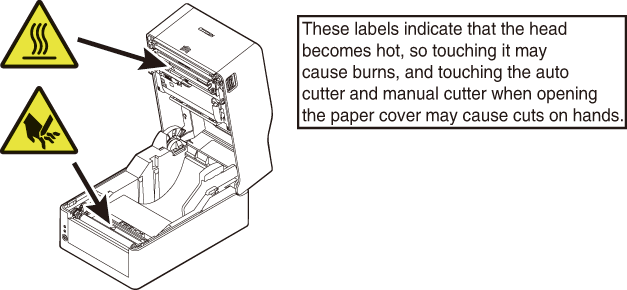
|
 CAUTION
|
- Do not touch the area around the thermal head during or right after the printing process.
This area will be hot and may cause burns.
- Do not drop or insert small objects such as clips or pins into the printer. Doing
so may result in failure.
- Exercise caution when carrying or transporting the device. Dropping the device may
damage other objects or cause injury.
- Make sure to open the printer cover fully when it needs to be opened. Failure to do
so may result in the printer closing unexpectedly, which may cause injury.
- Exercise caution when the printer cover is open. Contact with edges may result in
injury.
- Do not open the printer cover while the printer is printing.
- Do not print while the top ribbon cover is open. A failure may occur if the ribbon
is touched or a foreign object is dropped on it.
- Do not use thinner, trichlene, benzene, ketone-based solvents, or cleaning cloths
with chemicals to clean the case surface.
- Do not use the device in environments exposed to significant levels of oil, metal
shavings, waste, and dust.
- Do not spill liquids onto the device or expose the device to spray chemicals.
- Do not step on, drop, hit, or otherwise subject the device to significant force or
impact.
- Make sure to use the control panel correctly. Pressing buttons randomly may cause
malfunction and even failure. Do not use sharp objects including tips of pens to operate
the control panel.
- If some abnormality occurs during use, immediately stop using the device and disconnect
the power plug from the electrical outlet.
- Do not disassemble the device for repairs in case of failure. Always contact the dealer
for repairs.
- The auto cutter has internal blades near the media discharge port. Never insert hands
inside the media discharge port whether the printer is operating or not.
- There is a risk of the thermal head being damaged by static electricity. Take measures
to prevent the charging of static electricity in advance, and do not directly touch
the thermal head heating element and connector terminal parts when handling the printer.
- Clean the platen regularly because printing or cutting at the correct position may
become impossible if it is dirty.
- Paper with perforated lines will make the platen extremely dirty so cleaning when
starting use is recommended.
- Cutting at perforated lines is not recommended because an extremely large amount of
paper dust and paper scraps will be generated.
|
|
PRECAUTIONS ON PRINTER INSTALLATION
 CAUTION
|
- Do not use or store the device in environments exposed to excessive heat, moisture,
direct sunlight, near heaters, extremely high or low altitudes, excessive humidity,
or excessive dust.
- Do not use the device in environments, such as laboratories, where chemical reactions
occur.
- Do not use the device in environments exposed to air that contains salt or toxic gases.
- Place printers on level, stable surfaces in environments with good ventilation. (Do
not place the printer such that the vents are against walls.)
- Do not place objects on top of the device.
- Using the device near radios or televisions or plugging the power cord into the same
electrical outlet as used by such devices may cause reception interference.
- Use the device in environments at specified power supply voltage and frequency.
- Use only the included power cord. Do not use the included power cord with other devices.
- Do not place objects or step on power cords.
- Do not pull or attempt to carry the device by the power cord or an interface cable.
- Do not connect too many power cords to a single electrical outlet.
- Do not bundle the power cord.
- Hold the power cord by the power plug to connect and disconnect to/from electrical
outlets.
- Ensure connectors are properly connected. In particular, reversing the polarity may
damage internal parts.
- Turn the power switch off before connecting or disconnecting interface cables.
- Do not run long signal lines or make connections with noisy devices to the extent
possible. If necessary, use shielded twisted pair cables for signal lines and take
any other necessary steps to ensure signal integrity.
- Place the device near an electrical outlet and ensure that the power plug can be unplugged
easily so that the power to the device can be cut quickly if necessary.
- Use electrical outlets with ground terminal screws. Using electrical outlets without
ground terminals may result in injury due to static electricity.
- Do not install the printer in a location where there is vibration or in an unstable
location.
|
|
GENERAL OUTLINE
Thank you for purchasing the Citizen Systems Line Thermal Printer CL-E321 / CL-E331.
This printer is a line thermal printer employing the direct-thermal method and thermal-transfer
method that was developed for labels, tags, tickets, and many other applications.
Configuring Printer Settings Using the Specialized Utility
Use the LabelPrinterUtility configuration application to change printer settings.
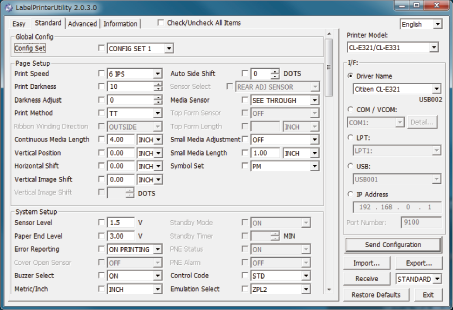
Refer to the following sections for more information on obtaining and using LabelPrinterUtility.
Configuring Ethernet Network Settings Using Network Seeker
You can check and change the settings of the wired LAN interface board by using CITIZEN
Network Seeker, which is utility software that runs in Windows.
Configuring Printer Settings Using a Browser
Printer and network settings can be configured using a Web browser via the printer’s
built-in LinkServer function.
Clearing Jobs Stored in the Printer
Jobs stored in the printer can be cleared when the printer is paused.
- 1.Press the FEED key if the printer is printing or receiving data.
- The printer is now paused.
- 2.Press and hold the FEED key for at least 3 seconds.
- The buzzer emits 1 short tone.
- 3.Release the FEED key.
- One job has been cleared.
- Alternatively, continue to press and hold the FEED key for at least 3 second without releasing your finger until the buzzer emits 2
short tones.
- 4.Release the FEED key once the buzzer emits 2 short tones.
- All jobs have been cleared.
Maintenance
Perform printer maintenance on a regular basis to ensure that the printer is always
in good working condition.
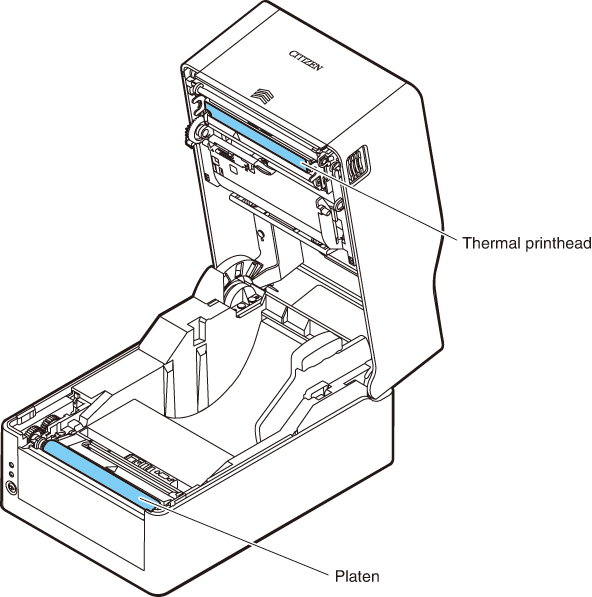

CAUTION
- Excluding ethyl alcohol, do not use solvents such as benzene, acetone, thinner, or
others to clean the printer. Doing so may cause the printer surface or other parts
to deform.
- CITIZEN is a registered trademark of Citizen Watch Co., Ltd.
- QR Code is a registered trademark of DENSO WAVE INCORPORATED.
- Datamax® is a registered trademark of Datamax-O'Neil Inc.
- Maxi Code is a registered trademark of UPS.
- Zebra®, Eltron®, ZPL2™, and EPL2™ are registered trademarks of ZIH Corp., USA
- PDF417 is a trademark or registered trademark of Motorola, Inc. in the U.S. and other
countries.
- TrueType™ is a trademark of Apple Inc.
- All other trademarks are the property of their respective owners.
- Citizen Systems use these trademarks in accordance with the license of relevant owners.
Copyright© CITIZEN SYSTEMS JAPAN CO., LTD. 2019
Features
< Compact and Stylish Design >
- Boasting the smallest footprint in the industry, this printer was designed to be compact
to free users from placement restrictions.
- The stylish design enables the device to be used in different environments.
- Exterior color options include black and pure white.
- This printer is compact yet allows you to use a 300 m per roll, large-diameter ink
ribbon.
< High-speed, High-quality Printing >
- This printer employs the direct-thermal method and thermal-transfer method by utilizing
a thermal head, and includes a 32-bit RISC CPU with a maximum operating frequency
of 216 MHz and thermal history control to provide high-speed, high-quality performance
up to 8 IPS with the CL-E321 model and up to 6 IPS with the CL-E331 model.
< Adjustable Sensors Provided as Standard >
- Adjustable media/black line sensors are provided as standard so that the detection
position can be adjustable horizontally. This enables sensors to be placed at detection
positions suitable for different types of media.
< Interface >
- Standard interfaces include a 9-pin, DSUB RS232C interface, full-speed USB 2.0 port,
and an Ethernet port that supports 100BASE-TX and 10BASE-T. These interfaces enable
high-speed connections to many peripheral devices.
< Excellent Usability >
- Manual media cutters are installed at the top and bottom of the media discharge port
to cut media after being printed for better usability in many different environments.
- The operation panel has been designed to have a different color than the main exterior
color for better visibility and stress-free operation.
- Thermal heads and platen rollers can be easily replaced without the use of tools.
< Easy to Use >
- The ribbon loading section has a structure that facilitates easy loading of a ribbon
thanks to the adoption of an up/down opening mechanism.
- Use the LabelPrinterUtility developed by Citizen to configure printer settings from a host computer.
- The built-in LinkServer™ printer tool can be used over Ethernet connections to change
settings and perform other operations.
- The printer includes mechanisms to allow you to easily adjust the head balance and
ribbon left/right balance.
<Models with cutter and models with AC adapter storage case are available>
- Models equipped with an auto cutter are also available.
- Models that allow you to store the AC adapter at the bottom of the printer are also
available.
Model Classification
Model numbers indicate printer features according to the following system.

- 1.Model name
- CL-E321: 203 DPI
- CL-E331: 300 DPI
- 2.Fixed value
- 3.Market
- A: Asia
- C: China
- E: Europe
- U: North America
- 4.Body case color
- B: Black
- W: Pure white
- 5.Interface
- N: USB port, wired LAN, and serial port
- 6.Cutter
- N: None
- BC: Available
- 7.AC adapter storage case
- A: Not available
- S: Available
Certain combinations may not be available. Please contact us for inquiries on desired
configurations.
Front of Printer
CL-E321X***NA (standard model)
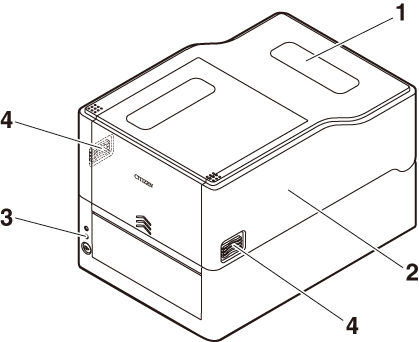
CL-E321X***NS (model with AC adapter storage case)
* The figure illustrates the standard model with AC adapter case.
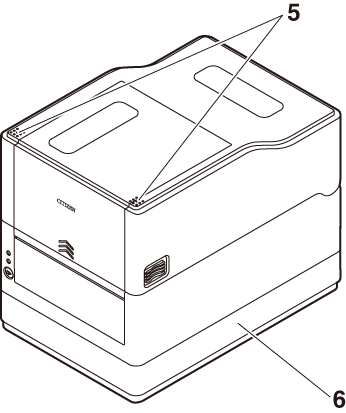
CL-E321X***BC (model with cutter)
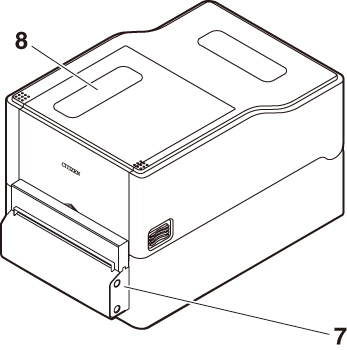
- 1.Media window
- Enables users to check the media level.
- 2.Top cover
- Opens upward so users can replace or set media.
- 3.Operation panel
- Includes 2 LEDs and 1 key.
- Enables users to perform different printer operations and check printer status.
- 4.Cover release buttons
- The cover is opened by pressing the buttons on both the right and left sides.
- 5.Push marks
- 6.AC adapter case
- 7.Auto cutter
- 8.Ribbon window
- Allows you to check the amount of ribbon that is remaining.
Operation panel
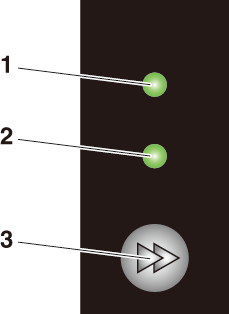
The operation panel includes 2 LEDs and 1 key.
- 1.Power LED
- Turns on when the power is turned on and turns off when the power is turned off.
- 2.Status LED
- Turns on or flashes in green, red, and amber depending on the printer status.
| Color |
Lights/flashes |
Status |
| Green |
On |
Printer is online |
| Flashes |
Receiving data |
| Amber |
On |
Startup |
| Red, green, amber |
Flashes |
Error or alarm |
| - |
Off |
Paused |
- 3.FEED key
- Feeds media when pressed while the printer is waiting to receive data.
- Pressing and holding this key for at least 3 seconds changes the operation mode to
the online configuration mode.
- Turning on the power to the printer while pressing and holding the FEED key with the cover closed changes starts the printer in the special function mode.
- Other key operation varies depending on the currently selected mode. Refer to “FEED Key Operation” for more information.
FEED Key Operation
Online state (status LED is solid green)
- (1)Press the FEED key while the printer is not receiving data to feed media.
- If label media is specified, the printer automatically stops after detecting the beginning
of media. If continuous media is specified, the printer stops after a certain amount
of feed operation.
- If Tear off mode is selected in the Function Select setting, the printer feeds media
to the tear-off position.
- For models with a cutter, the printer will feed media to the cut position and then
cut the media.
- (2)Press and hold the FEED key for at least 3 seconds while the printer is not receiving data to change the
operation mode to the online configuration mode.
Printing (status LED is solid or flashing in green)
Press the FEED key while the printer is printing or receiving data to pause the printer.
- The status LED turns off, and the printer pauses.
- If the FEED key is pressed while the printer is printing, the printer will finish printing the
current label and then stop.
Press the FEED key again to resume printing operation for the remaining labels in the print job.
Paused (status LED is off)
Press and hold the FEED key to change to the clear job mode.
Error/alarm has occurred (status LED flashes in red, green, or amber)
Press the FEED key to clear the error or alarm.
Rear of Printer
CL-E321X***NA (standard model)
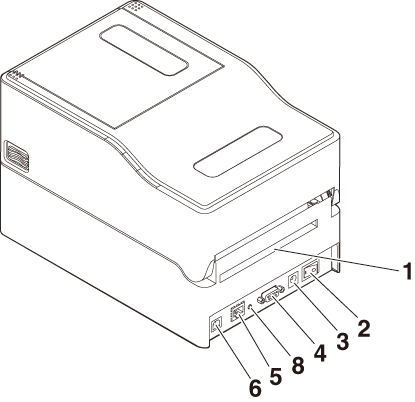
CL-E321X***NS (model with AC adapter storage case)
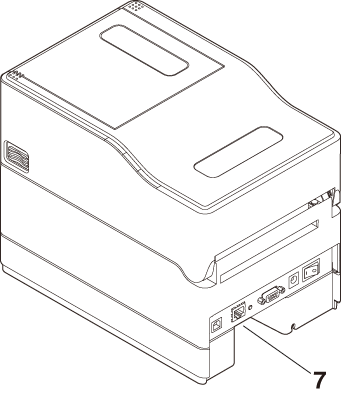
CL-E321X***BC (model with cutter)
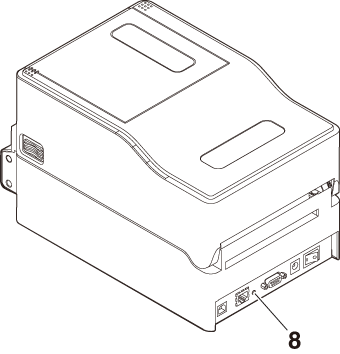
- 1.External media feed port
- This port is used to feed media into the printer.
- 2.Power switch
- Turns the printer power supply on and off.
- 3.DC jack
- Connects to the included AC adapter.
- 4.D-SUB 9pin serial interface
- 5.Ethernet Interface
- 6.USB interface
- 7.AC port
- 8.Ethernet panel button
- This button prints and initializes network settings.

CAUTION
- Do not connect a USB cable to the Ethernet interface. Doing so may damage connectors/interfaces.
Inside of Printer
CL-E321X***NA (standard model)
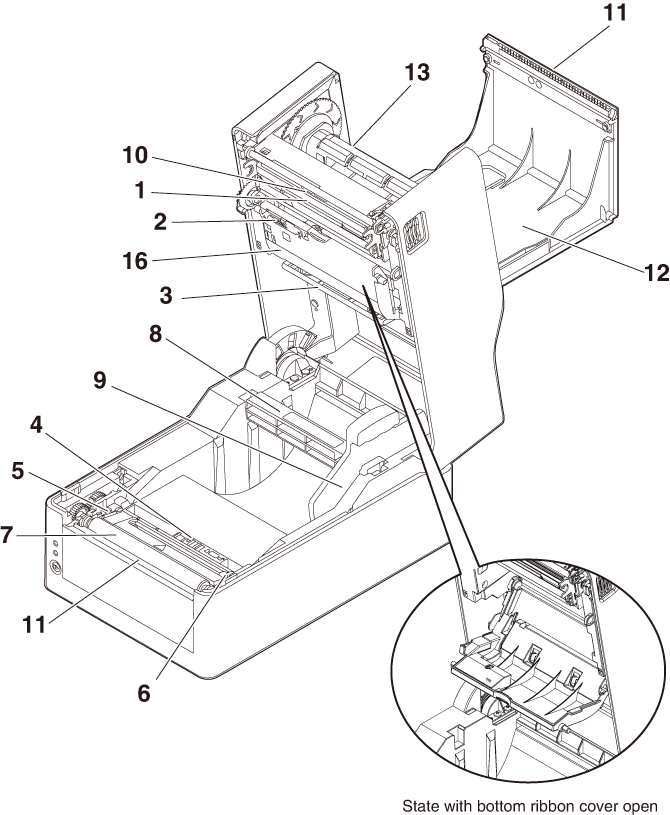
CL-E321X***BC (model with cutter)
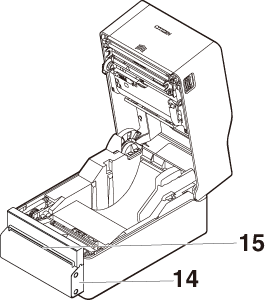
- 1.Thermal head
- Prints characters and graphic data on paper (paper rolls).
- 2.Upper sensor
- This sensor detects the media position.
- 3.Media damper
- When using roll media, absorbs tension generated by media feed operations to prevent
print errors.
- 4.Bottom sensor
- This sensor detects the media position.
- Devices are equipped with lock mechanisms.
- 5.Fixed left-side media guide
- 6.Adjustable right-side media guide
- 7.Platen roller
- This roller transports media.
- 8.Media shaft
- 9.Media shaft guide
- 10.Head balance adjustment slider
- 11.Manual cutter (Upper/Bottom)
- 12.Top ribbon cover
- Open this to replace or install the ribbon.
- 13.Ribbon shaft
- Pass the shaft through the core of the ribbon to install the ribbon in the printer.
- 14.Auto cutter
- 15.Media discharge port
- 16.Bottom ribbon cover
- Open this to replace or install the ribbon.
Printing Preparation Process
The printer must be set up according to the following process before printing can
be performed.
Refer to the description of each section for detailed information on each step of
the process.
- 1.Unpack and check the package contents
- 2.Physical installation
- 3.Loading Media
- 4.Loading a Ribbon
- 5.Adjusting Media Sensor Positions
- 6.Connecting the AC Adapter
- 7.Connecting the Printer to a Host Computer
- 8.Operation Check
- 9.Installing the Printer Driver onto the Host Computer
- 10.Installing the Configuration Application onto the Host Computer
- 11.Printing
- Perform a test print from the printer driver installed on the host computer.
Loading Paper
- 1.Press the cover release buttons on both the right and left sides to open the top cover.

CAUTION
- Note the following precautions when the top cover is open.
- Do not touch the thermal head.
- 2.Insert the media shaft through the core of the media roll and then install the media
shaft guide.
- The media shaft is designed to accommodate both 1-inch and 1.5-inch media roll cores
by flipping it upside down. The media shaft has markings indicating which side supports
the different core sizes. Select the media shaft orientation in accordance with the
size of the media roll core.
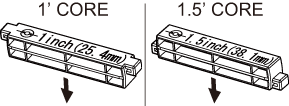

CAUTION
- Use media rolls that have the print surface on the outer side. Do not use media rolls
that have the print surface on the inner side. Labels may peel when such media roll
is back-fed.
- If the media shaft is not installed correctly, the top cover or bottom of the printer
will prevent media from feeding properly and cause paper jams.
- 3.Set the media so that the media shaft guide is on the right side of the media when
looking at the front of the printer.
- 4.Press the media shaft guide onto the media roll so that the center of the media aligns
with the center of the media shaft and then set the media into the printer.
- 1.Assemble the media shaft and media shaft guide.
- 2.Insert the media shaft through the core of the media roll and then set the assembly
into the printer.
- 3.Set the media in the printer and slide the media to the left from the perspective
of looking at the front of the printer. Insert the media shaft guide into the paper
at this position.
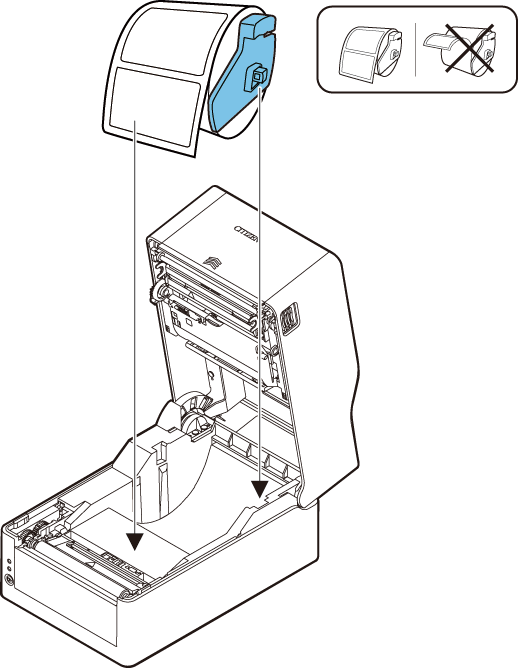

CAUTION
- Too much abutment force by media shaft guide may cause improper feeding of media,
which may negatively impact print quality.
- 5.If using a model with a cutter (CL-E321X***BC), pass the media through the cutter slit.
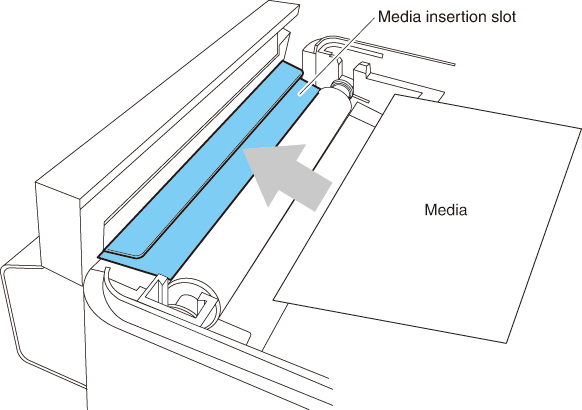

CAUTION
- Insert media into the slit correctly. Failure to do so may result in improper feeding
of media, which may cause paper jams.
- 6.Make sure the media is in abutment with the left media guide and then adjust the position
of the right media guide in accordance with the media width.
- From the front of the printer, set in front of the edge of media by approximately
10 mm.
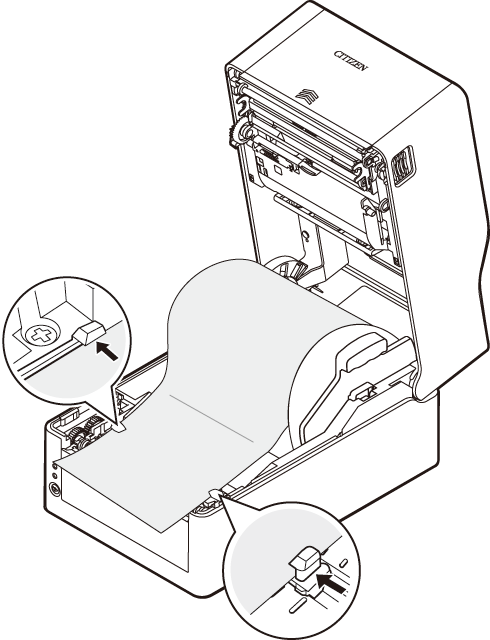

CAUTION
- Too much abutment force of the right movable paper guide may cause improper feeding
of media, which may negatively impact print quality.
- 7.Slide the head balance adjustment slider located near the thermal head along the media
size scale (inch) so that the position of the notch in the slider matches the media
width.
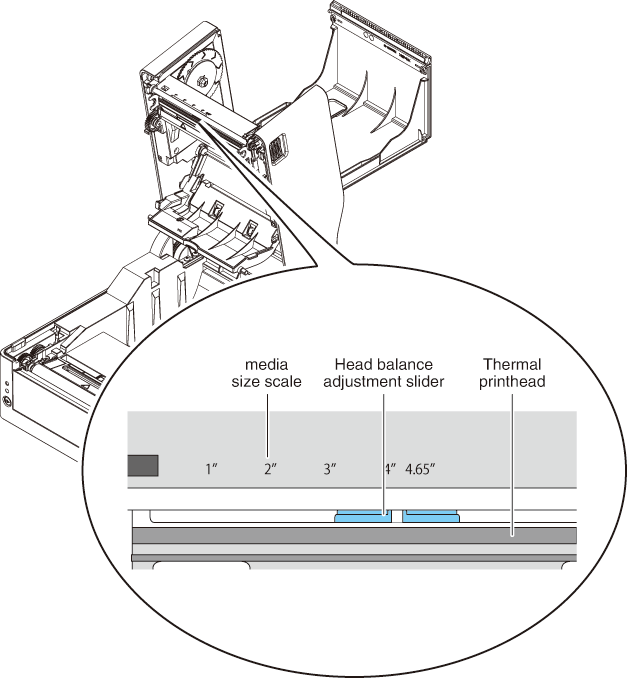

CAUTION
- Adjust the head pressure horizontal balance carefully so as not to damage the thermal
head.
Damaged thermal heads will result in poor printing, paper jams, and malfunction.
- If using media in thermal-transfer printing with a width of 2 inches or less, we recommend
setting the head balance adjustment slider to 2.5" (between 2" and 3").
- 8.Close the top cover.

CAUTION
- Press the push marks on left and right sides at the top of the top cover and ensure
that the top cover hooks on each side lock securely.
If the top cover is not securely locked, this may cause print errors, paper jams,
and malfunction.
Compatible Paper Types

CAUTION
- Continuous label media cannot be used with the model that has a cutter. Using such
media may cause the label media adhesive to accumulate on the cutter blade, which
could result in a failure.
Refer to the following specification table for information on the types of media compatible
with this printer.
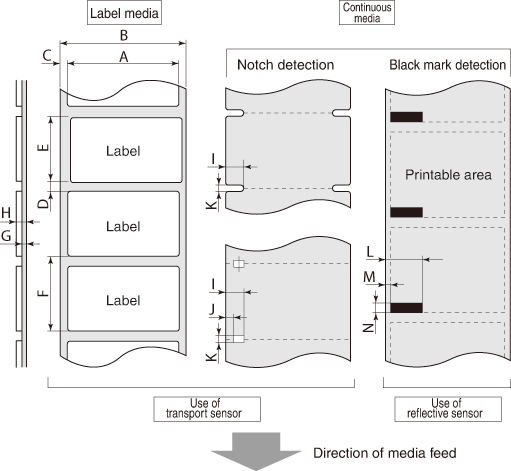
|
Minimum value |
Maximum value |
| mm |
inch |
mm |
inch |
| A |
Label width |
21.50 |
0.83 |
118.00 |
4.65 |
| B |
Backing paper width |
25.40 |
1.00 |
118.00 |
4.65 |
| C |
Left edge position of label |
0 |
0 |
2.54 |
0.10 |
| D |
Label gap length |
2.54 |
0.10 |
2,539.75 (CL-E321)1,270.00 (CL-E331) |
99.99 (CL-E321)
50.00 (CL-E331) |
| E |
Label length |
6.35 |
0.25 |
2,539.75 (CL-E321)1,270.00 (CL-E331) |
99.99 (CL-E321)
50.00 (CL-E331) |
| F |
Label pitch |
8.89 |
0.35 |
2,539.75 (CL-E321)1,270.00 (CL-E331) |
99.99 (CL-E321)
50.00 (CL-E331) |
|
|
| G |
Backing paper thickness |
0.06 |
0.0025 |
0.125 |
0.0049 |
| H |
Total media thickness |
0.06 |
0.0025 |
0.19 |
0.0075 |
|
| I |
Notch right edge position |
8.3 |
0.32 |
60.80 |
2.39 |
| J |
Notch left edge position |
0 |
0 |
57.20 |
2.25 |
| K |
Notch length |
2.54 |
0.10 |
17.80 |
0.70 |
| L |
Black line right edge position |
15.00 |
0.59 |
66.50 |
2.62 |
| M |
Black line left edge position |
0 |
0 |
51.50 |
2.02 |
| N |
Black line length |
3.18 |
0.125 |
17.80 |
0.70 |
- Use the transmissive sensor when using media that has both gaps between labels and
black lines.
- Use the transmissive sensor when using fanfold media.
- If the label pitch is 1 inch or less, configure an accurate label pitch with the [Small Media Adjustment] setting.
- Use carbon-based ink with an OD value of at least 1.5 to print black lines.
- The stop position and cut position may change depending on the width or type of media
that is used.
Adjust these positions using the Paper Position setting.
Loading a Ribbon
How to Load a Ribbon
Adjusting the Left/Right Balance of the Ribbon
If the left/right balance of the ribbon needs to be adjusted, adjust it by moving
the ribbon left/right balance adjustment knob.
If wrinkles are occurring in the ribbon, make the adjustment described in the following
procedure.
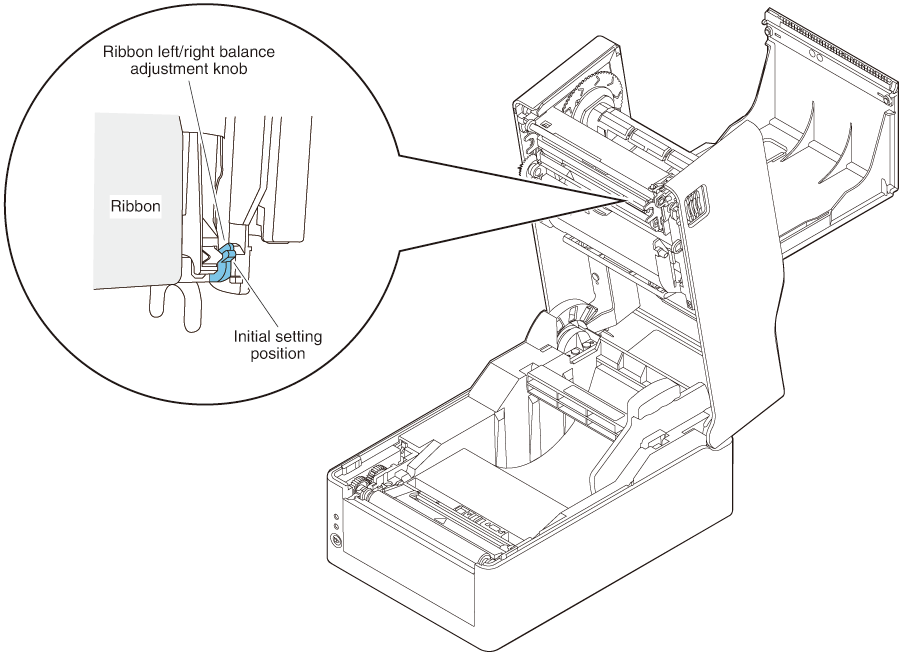
Adjusting Media Sensor Positions
This section describes the procedure to adjust sensors when loading media. Transmissive
and reflective sensors can be used for the media sensors.
The printer comes from the factory equipped with a transmissive sensor. The media
sensor must be replaced with a reflective sensor for certain types of media.
Range of Paper Sensor Adjustment
The following figure illustrates the range of media sensor adjustment.
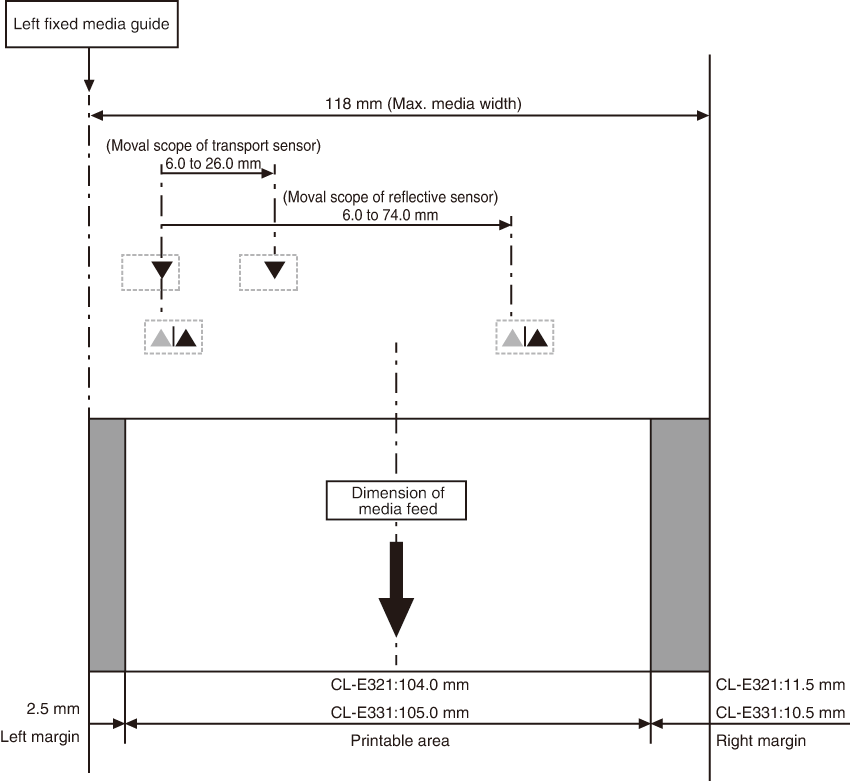
Transmissive Sensor Adjustment
- ●Adjust the position of the bottom sensor and upper sensor in accordance with the media
width.
- Move the bottom sensor and upper sensor by the same number of steps from the position
of the triangle (▲).
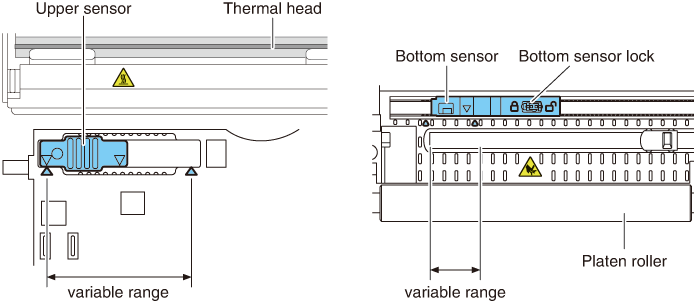
- The range of bottom sensor and upper sensor horizontal adjustment is 10 steps between
the triangle marks (▲).
- Use a pen or other object with a narrow tip to unlock the bottom sensor and then reposition
it.
Lock the sensor in place once the new position has been determined.

CAUTION
- The bottom sensor and upper sensor must be in alignment with each other.
- Attempting to move the sensor while still locked may damage it.
Reflective Sensor Adjustment
- ●Set the bottom sensor at a position so that the center of the sensor window is in
alignment with the center of the black line.
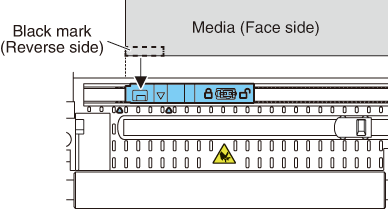
Connecting the AC Adapter

CAUTION
- Use the dedicated AC adapter designed for this device.
- Make sure the power switch on the printer is turned off before connecting the AC adapter.
- Insert the AC adapter connector completely into the DC jack.
- 1.Insert the DC plug on the output side of the AC adapter into the DC jack in the printer.
- 2.Insert the plug of the AC cord into an electrical outlet.
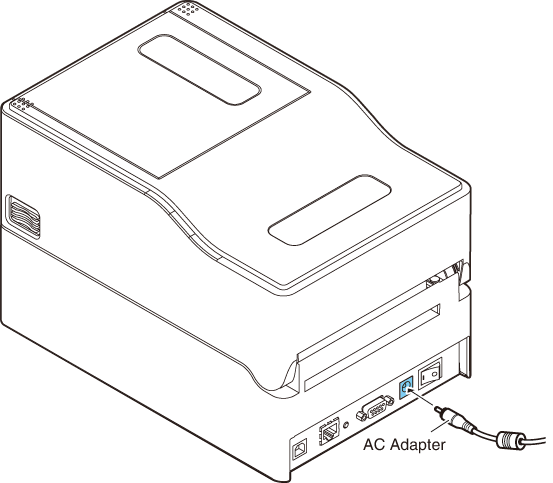
For a model with an AC adapter storage case
- ●Insert the plug of the AC cord into the AC port.
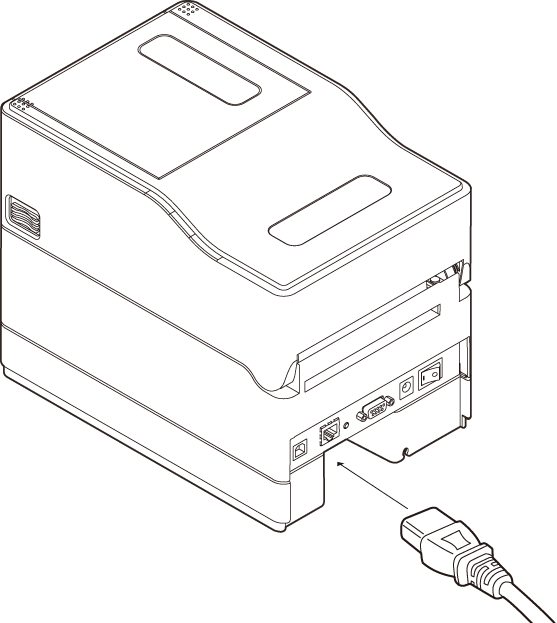
Connecting the Printer to a Host Computer
This printer is equipped with print data interfaces including a USB port, an Ethernet
port, and a serial port.
Use the following procedure to connect this printer to a host computer.

CAUTION
- Interface cables are required to connect the printer to a host computer.
- 1.Turn off the power to the printer and host computer.
- 2.Insert the cable into the appropriate interface port at the back of the printer.
- Tighten any locking screws to secure the cable.
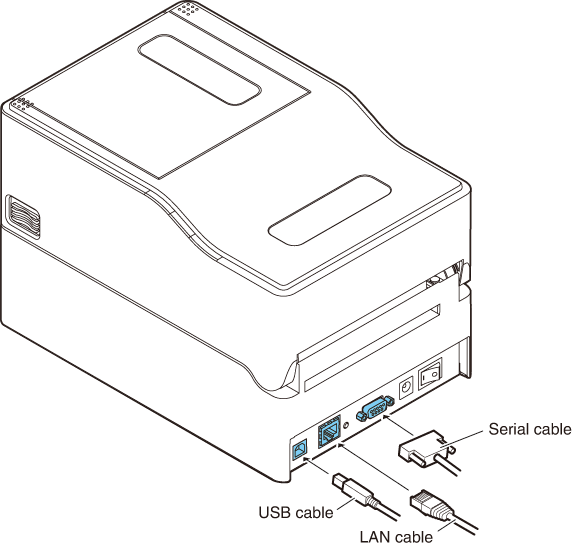
- 3.Insert the other end of the cable into the appropriate interface port in the host
computer.
- Tighten any locking screws to secure the cable.
Using an Ethernet connection
Configure network settings as necessary.

CAUTION
- To check the current Ethernet settings, press the Ethernet panel button located next
to the Ethernet interface to printout the settings.
- To initialize Ethernet settings, press and hold the Ethernet panel button for at least
3 seconds. Once the buzzer emits a short tone, press and hold the Ethernet panel button
again within 3 seconds for at least 3 seconds.
Install the Printer Driver
Install the printer driver onto the host computer.
Printer drivers are available for download from the Citizen Systems support website.
The latest documentation, drivers, utilities, and other support information are also
available from this website.
http://www.citizen-systems.co.jp/support/download/printer/label/index_en.htmlOnce a printer driver has been downloaded, follow the on-screen instructions to install
the driver.
List of Settings
This section describes the procedures to configure printer settings using the LabelPrinterUtility.
The following table lists the settings configurable with LabelPrinterUtility.
| Home menu |
Sub menu |
Default |
Configurable range |
Notes |
| Page Setup |
Print Speed |
6 IPS |
CL-E321:
2 to 8 IPS
CL-E331:
2 to 6 IPS |
Sets the print speed |
| Print Darkness |
10 |
00 to 30 |
Adjusts the print density |
| Darkness Adjust |
00 |
-10 to 10 |
Fine adjustment of the density command |
| Print Method |
TT |
TT
DT
|
Selects thermal-transfer (ribbon) or direct-thermal media |
| Continuous Media Length |
4.00 inch
101.6 mm
|
CL-E321:
0.25 to 99.99 inch
6.4 to 2539.7 mm
CL-E331:
0.25 to 50.00 inch
6.4 to 1,270.0 mm
|
Sets the length of continuous mediaThe lower row shows millimeter values when using the printer in mm mode |
| Vertical Position |
0.00 inch
0.0 mm
|
-1.00 to 1.00 inch
-25.4 to 25.4 mm
|
Adjusts the printing start position |
| Horizontal Shift |
0.00 inch
0.0 mm
|
-1.00 to 1.00 inch
-25.4 to 25.4 mm
|
Adjusts the horizontal image position |
| Vertical Image |
(Datamax)
0.00 inch
0.0 mm
|
0.00 to 32.00 inch
0.0 to 812.8 mm
|
Adjusts the start position for creating images |
| (Zebra/Eltron)000 dots |
-120 to 120 dots |
| Auto Side Shift |
0 dots |
0 to 15 dots |
Shifts the horizontal print position by the specified number of dots for each sheet/label.
This is useful when significant load is placed on the portion of the thermal head,
such as when printing vertical borders.
|
| Media Sensor |
See Through |
See Through
Reflect
None |
Selects the type of label sensor type |
| Small Media Adjustment |
Off |
On
Off |
Setting for small label support |
| Small Media Length |
1.00 inch
25.4 mm
|
0.25 to 1.00 inch
6.4 to 25.4 mm
|
Sets the length for small label media |
| Symbol Set |
PM |
50 options |
Sets the character set |
| Home menu |
Sub menu |
Default |
Configurable range |
Notes |
| System Setup |
| Sensor Level |
1.5 V |
0.0 V to 3.3 V |
Sets the sensor threshold |
| Paper End Level |
3.00 V |
0.01 V to 3.30 V |
Sets the paper end level |
| Error Reporting |
On Printing |
On Printing
Immediate |
Error reporting setting |
| Buzzer Select |
Exec/Err |
Exec/Err
All
Error
Key
None |
Sets the conditions at which the buzzer is triggered |
| Metric/Inch |
Inch |
Inch
mm |
Sets the unit of measure |
| Max Media Length |
10.00 inch
254.0 mm
|
CL-E321:
1.00 to 99.99 inch
25.4 to 2539.7 mm
CL-E331:
1.00 to 50.00 inch
25.4 to 1,270.0 mm
|
Sets the maximum length of label media |
| Settings Lock |
Off |
On
Off |
Prevents changes via setting commands |
| Keyboard Lock |
Off |
On
Off |
Prevents changes via key operation |
| Control Code |
STD |
STD
ALT
ALT-2 |
Changes the command mode for DMX mode (only when Datamax® emulation is selected) |
| Media Power Up |
Off |
On
Off |
Sets the media length measuring function when the power is turned on (only when Zebra®
emulation mode is selected on international models)
|
| CI Lock |
Off |
On
Off |
Prevents changes via CI commands (only when Zebra® emulation mode is selected on international
models)
|
| Emulation Select |
DM4 (Datamax®)ZPI2 (Zebra®) |
DM4
DMI
DPP
ZPI2
EPI2 |
Datamax®/Zebra® compatibility selection
DM4 Datamax® 400
DMI Datamax® IClassTM
DPP Datamax® Prodigy Plus®
ZPI2 Zebra® ZPL2TM
EPI2 Zebra® EPL2TM |
| Emulation Auto Detect |
Full Auto |
On
Off
Full Auto |
Sets the emulation sensing function (international models only) |
| Home menu |
Sub menu |
Default |
Configurable range |
Notes |
| After Print - 1 |
AutoConfigure |
On |
On
Off |
Enables/disables the auto configuration of optional equipment.
On - Enables auto configuration (when a cutter is installed, mode is automatically configured
regardless of the Function Select setting)
Off - Disables auto configuration. Turn this setting Off and select operation with Function Select when you do not want to use the cutter if installed.
|
| Function Select |
Tear |
Off
Tear
Cut On(only valid for models with cutters) |
Selects the operation mode when AutoConfigure is Off. Each option has a specified media stop position. Enables operation of the applicable
device when selected.
|
Cutter Action
*Only valid for models with cutters |
Backfeed |
Backfeed
Through |
Cutter action setting
Prints only when AutoConfigure for a model with a cutter is On or when [Backfeed] is selected for the Function Select setting.
The [Backfeed] option performs a back-feed after each cut operation.The [Through] option continues the print operation at the trailing edge of each sheet/label from
the first sheet/label to the n-1 sheet/label when the number of copies is set to n.
A back-feed operation is then performed at the trailing edge of the last sheet/label
or when printing a single sheet/label.
|
| Home menu |
Sub menu |
Default |
Configurable range |
Notes |
| After Print - 2 |
Paper Position |
0.00 inch
0.00 mm
|
STD
0.00 to 2.00 inch
0.0 to 50.8 mm
Cut/Tear-
1.00 to 1.00 inch
-25.4 to 25.4 mm
|
Adjusts the stop position.
This setting is dependent on the Metric/Inch setting.
Each device has an initial stop position as configured with the settings previously
described. This setting sets a relative value from these other settings.
|
| Feed Key Action |
Feeds Media |
Repeat Last Set
Repeat Last One
Feeds Media |
Changes the operation of the FEED key
Repeat Last Set
Reprints a set of labels.
This setting is ignored when Zebra®* emulation mode is selected.
Repeat Last One
Reprints the last page only.
Prints only 1 sheet/label from the current number when using counts.
Feeds Media
Functions as the FEED key.
Disables reprinting.
|
| Home menu |
Sub menu |
Default |
Configurable range |
Notes |
| Interface*1 |
RS-232C Baud Rate |
9600 |
115200
57600
38400
19200
9600
4800
2400 |
Sets the baud rate of the serial interface |
| RS-232C Parity |
None |
None
Odd
Even |
Sets the communication parity of the serial interface |
| RS-232C Length |
8 bits |
8 bits
7 bits |
Sets the data length for the serial interface |
| RS-232C Stop bit |
1 bit |
1 bit
2 bits |
Sets the stop bits for the serial interface |
| RS-232C X-ON |
Yes |
Yes
No |
Enables/disables X-ON flow control for the serial interface |
| USB Device Class |
Printer |
Printer
VCOM |
Sets the USB device class |
| USB VCOM Protocol |
Auto |
Auto
DTR
X-ON |
Sets the USB VCOM protocol (flow control) |
| IPv4 Address |
169.254.001.010 |
000.000.000.000 to 255.255.255.255 |
Sets the IPv4 network address |
| IPv4 Subnet Mask |
255.255.000.000 |
000.000.000.000 to 255.255.255.255 |
Sets the IPv4 subnet mask |
| IPv4 Gateway |
000.000.000.000 |
000.000.000.000 to 255.255.255.255 |
Sets the IPv4 gateway |
| IPv4 DHCP |
On |
On
Off |
Enables/disables IPv4 DHCP |
| Host Name |
CL-E321:
CL-E321/300
Print Server
CL-E331:
CL-E331/303
Print Server
|
Any length from 0 to 31 characters long using single-byte letters (uppercase and lowercase),
numbers, and symbols
|
Name to assign to the device to identify the printer |
| Port Number |
9100 |
1024 - 65535 |
Print port number |
| Timeout |
60 |
0 - 300 |
Timeout time (in seconds) for connection with host machine
When the set number of seconds elapses without data being received from the host in
the state in which a session is established, a timeout occurs and the session is disconnected.
If this is set to 0, there will be no timeout.
|
| Action at timeout |
Close all |
Close all
Move next
|
Pending session processing when timeout
Sets whether to disconnect all other sessions or to enable sending and receiving when
there are two or more sessions established and a timeout occurs for the session that
was established first
|
| Transmits buffered data |
Disable |
Disable
Enable
|
Transmission data processing when host machine not connected |
| IPv6 |
On |
On
Off |
Enables/disables IPv6 |
| Fixed IPv6 Address |
On |
On
Off
|
Enables/disables IPv6 static network address |
| IPv6 Address |
0.0.0.0.0.0.0.0.0.0.0.0.0.0.0.0 |
0.0.0.0.0.0.0.0.0.0.0.0.0.0.0.0 -
255.255.255.255.255.255.255.255.255.255.255.255.255.255.255.255
|
Sets a IPv6 network address
Example: If the network address you wish to set is 2001:0db8:0000:0123:4567:89ab:cdef:feed,
specify the value for each network address field in decimal notation separated by
periods as shown below.
32.1.13.184.0.0.1.35.69.103.137.171.205.239.254.237
|
| IPv6 Prefix Length |
64 |
1 - 128 |
IPv6 prefix length setting (in bits) |
| IPv6 Gateway |
0.0.0.0.0.0.0.0.0.0.0.0.0.0.0.0 |
0.0.0.0.0.0.0.0.0.0.0.0.0.0.0.0 -
255.255.255.255.255.255.255.255.255.255.255.255.255.255.255.255
|
IPv6 gateway address setting
For how to specify an address, refer to the Notes column in “IPv6 Address”.
|
*1 Contains menus of option interface settings that can be configured for this printer.
| Home menu |
Sub menu |
Default |
Configurable range |
Notes |
| Global Configuration |
- |
Config Set 1 |
Config Set 1
Config Set 2
Config Set 3 |
Configuration number setting |
| Machine Information |
Model Number*2 |
- |
CL-E321 |
Displays the model number.
*Appears as “CL-E331” for the CL-E331 model. |
| Serial Number |
- |
RH******** |
Displays the serial number |
| Boot Version*2 |
- |
*.* |
Displays the boot version |
| ROM Version*2 |
- |
******** |
Displays the ROM version |
| ROM Date*2 |
- |
**/**/** |
Displays the ROM creation date |
| ROM CheckSum*2 |
- |
**** |
Displays the ROM checksum |
| Print Counter |
- |
****.*** km |
Displays the print counter |
| Service Counter |
- |
****.*** km |
Displays the service counter |
| Cut Counter |
- |
******* |
Displays the cut counter only for models with cutters |
| Sensor Monitor*2 |
- |
*.* V |
Displays the sensor level |
| MAC Address |
- |
**.**.**.**.**.** |
Displays the MAC address |
*2 This cannot be obtained with LabelPrinterUtility. To check the value, print the
list of settings.
Obtaining the LabelPrinterUtility
Using the LabelPrinterUtility
- ●Start LabelPrinterUtility.exe.
- Refer to the user manual for more information on using the application.
Starting Network Seeker
After obtaining the program “NetSeeker.exe” from the CD-ROM or our website, double click the program. A dialog box appears.
Start a search for printers by clicking the Seek button.
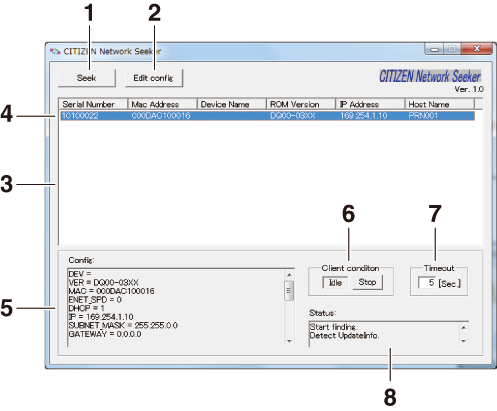
- 1.“Seek” button
- Start a search for Ethernet interface boards on the network.
- Waits for a response during the time configured with [Communication timeout].
- 2.“Edit config” button
- Change the settings of the selected board.
- 3.Board information list
- Single click to select a board and double click to change settings.
- 4.Board information
- Single click to select a board and double click to change settings.
- 5.Configuration display section
- View the settings of the selected board.
- 6.Client condition display
- When “Busy” is displayed, operations to search, change settings, and so on are prohibited.
- If you click “Stop”, the “Busy” status is cleared forcibly.
- 7.Communication timeout
- You can configure the time-out duration for searches and other operations.
- 8.Status log
- View the status of the utility.
Changing Settings
You can configure an Ethernet interface board by selecting it at the main dialog box,
and then clicking “Edit config”.
- These are unalterable parameters.
- These parameters are for display purposes only.
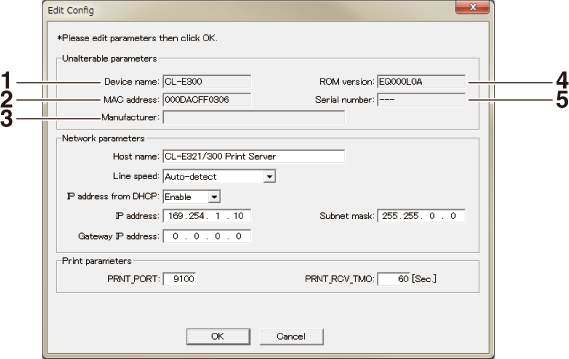
- 1.Device name
- 2.MAC address
- 3.Manufacturer
- 4.ROM version
- 5.Serial number
- These are changeable parameters.
- Users can change these parameters.
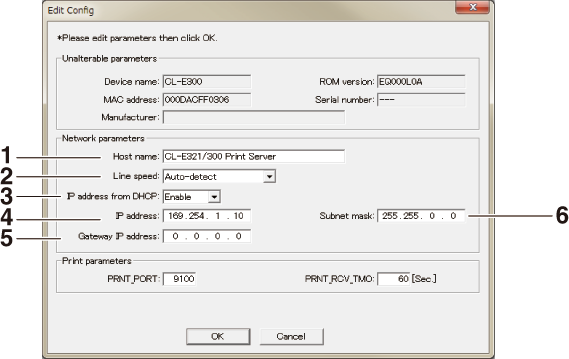
- 1.Host name
- 2.Line speed
- 3.IP address from DHCP
- 4.IP address
- 5.Gateway IP address
- 6.Subnet mask
LinkServer user roles
LinkServer has the following three user roles available: User, Operator, and Administrator
The menus that appear for each user role can be changed to restrict operational access
to LinkServer.
The Home screen for the user role appears when first connecting.
LinkServer menu configuration
The following figure illustrates the LinkServer menu configuration.
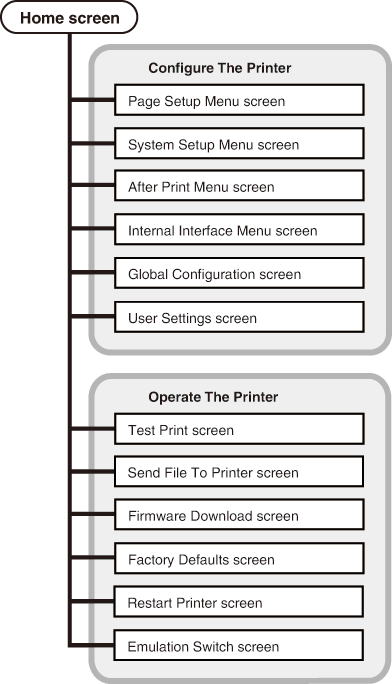
LinkServer connection procedure
Sensor Adjustment Mode
Use this mode to adjust media sensors (upper or lower) in accordance with the media
used.
Set the sensor position and media before starting this adjustment procedure.
Setting transmissive sensor positions and media
- 1.Align the bottom sensor and upper sensor with each other at the same position.
- 2.Peel a label and set the media so that only the backing paper (glassine paper) reaches
the platen roller and media sensor.
- If the media has black lines, do not set the media so that a black line is between
the sensors.

- 3.Adjust the sensors.
Setting reflective sensor positions and media
- 1.Adjust the reflective sensor so that it is underneath the media.
- 2.Set the media so that the media covers the platen roller and media sensor.
- Set that media so that black lines or gaps between labels do not cover the sensor.
- Using continuous media and label media without gaps between labels
- Set the media so that a section without a black line (or label face stock for label
media) does cover the platen roller and media sensor.
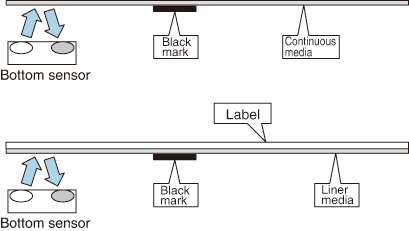
- Using label media with gaps
- Peel a label and set the media so that only the backing paper (glassine paper) reaches
the platen roller and media sensor.

- 3.Adjust the sensors.
Sensor adjustment
- 1.Turn on the power to the printer while pressing and holding the FEED key to start the printer in special function mode.
- 2.Press the FEED key once to select sensor adjustment mode.
- The buzzer emits 1 short tone.
The status LED also flashes in green.
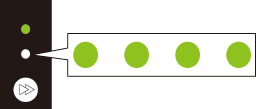
- 3.Press and hold the FEED key for at least 3 seconds.
- 4.Release the FEED key once the buzzer emits a long tone and then press the FEED key again.
- The printer is now in sensor adjustment mode.
- 5.Press the FEED key to select either transmissive sensor or reflective sensor.
- Each press of the FEED key toggles between transmissive sensor and reflective sensor options.
| Sensor |
Buzzer |
Status LED |
| Color |
Interval |
| Transmissive sensor |
1 short tones |
Green |
Flashes |
 |
| Press the FEED key ↕ |
| Reflective sensor |
2 short tones |
Green |
Flashes quickly |
 |
- 6.Press and hold the FEED key for at least 3 seconds.
- 7.Release the FEED key once the buzzer emits a long tone.
- The sensor adjustment process starts.
- Once sensors have been adjusted, the buzzer emits 1 short tone.
- The buzzer emits 1 long tone if sensor adjustment fails. If this happens, check the
sensor and media positions.
- 8.To save and complete the sensor adjustments, press and hold the FEED key for at least 3 seconds.
- The buzzer emits 4 short tones, and the printer restarts.
Test print mode
This mode prints the test sample.
This printer can print test samples to label media and continuous media.
Printing test samples is a quick way to check print quality.
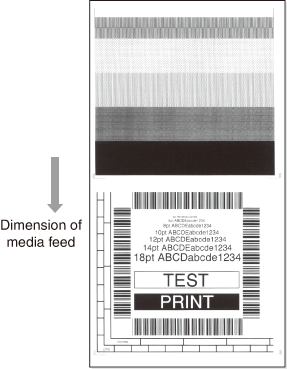
Load media and then perform the following procedure.
- 1.Turn on the power to the printer while pressing and holding the FEED key to start the printer in special function mode.
- 2.Press the FEED key twice to select test print mode.
- The buzzer emits 2 short tone.
The status LED also flashes quickly in green.
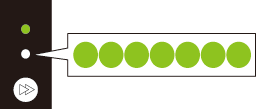
- 3.Press and hold the FEED key for at least 3 seconds.
- 4.Release the FEED key once the buzzer emits a long tone.
- The printer is now in test print mode.
- 5.Press the FEED key to select the media.
- Each press of the FEED key toggles between label media and continuous media.
| Media |
Buzzer |
Status LED |
| Color |
Interval |
| Label media |
1 short tones |
Green |
Flashes |
 |
| Press the FEED key ↕ |
| Continuous |
2 short tones |
Green |
Flashes quickly |
 |
- 6.Press and hold the FEED key for at least 3 seconds.
- 7.Release the FEED key once the buzzer emits a long tone.
- The test print process starts.
- Once the test sample has been printed, press the FEED key to print another test sample without a feed operation.
- 8.Once the test sample has been printed, turn the power to the printer off and on again
to reset the printer in the normal startup mode.

CAUTION
- Normal mode printing can also be performed when the printer is in test print mode.
Note that pressing the FEED key while the printer is in test print mode will not feed media. Instead, it will
print a test sample.
Configuration Print Mode
This mode is used to print the printer settings configuration when using continuous
media mode.
Printing the current settings configuration is a quick way to check the current configuration.
Example of printed settings configuration
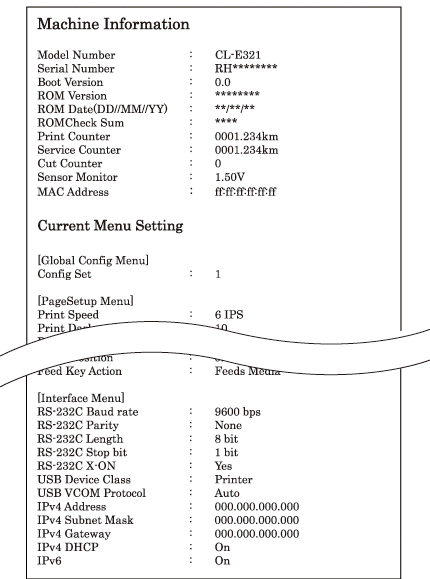
Load media and then perform the following procedure.
- 1.Turn on the power to the printer while pressing and holding the FEED key to start the printer in special function mode.
- 2.Press the FEED key 3 times to select configuration print mode.
- The buzzer emits 3 short tone.
The status LED also flashes in amber.
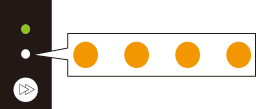
- 3.Press and hold the FEED key for at least 3 seconds.
- 4.Release the FEED key once the buzzer emits a long tone.
- The configuration print process starts.
- Once the configuration has been printed, the printer will be in the online state.
- 5.To print configurations that include default settings, continue pressing and holding
the FEED for at least 3 seconds without releasing your finger at step 4.
- 6.Release the FEED key once the buzzer emits a long tone and then press the FEED key again.
- The process to print a configuration that includes default settings starts.
- Once the configuration has been printed, the printer will be in the online state.
HEX Dump Mode
This mode is used to print a hex dump list (data received by the printer represented
in hex values) for confirmation of the data content.
Example of dump list printing
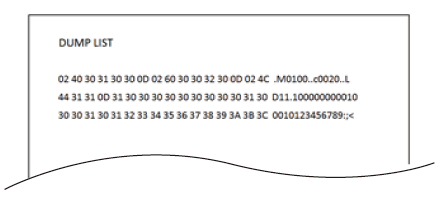
Load media and then perform the following procedure.
- 1.Turn on the power to the printer while pressing and holding the FEED key to start the printer in special function mode.
- 2.Press the FEED key 5 times to select HEX dump mode.
- The buzzer emits 5 short tone.
The status LED also flashes in red.
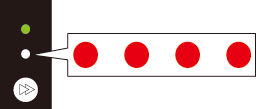
- 3.Press and hold the FEED key for at least 3 seconds.
- 4.Release the FEED key once the buzzer emits a long tone.
- The printer is now in HEX dump mode.
- 5.Press the FEED key to select the media.
- Each press of the FEED key toggles between label media and continuous media.
| Media |
Buzzer |
Status LED |
| Color |
Interval |
| Label media |
1 short tones |
Green |
Flashes |
 |
| Press the FEED key ↕ |
| Continuous |
2 short tones |
Green |
Flashes quickly |
 |
- 6.Press and hold the FEED key for at least 3 seconds.
- 7.Release the FEED key once the buzzer emits a long tone and then press the FEED key again.
- The hex dump list print process starts.
- 8.Once the HEX dump list has been printed, turn the power to the printer off and on
again to reset the printer in the normal startup mode.
Initialization Mode
This mode is used to initialize printer settings and the user memory area.
- 1.Turn on the power to the printer while pressing and holding the FEED key to start the printer in special function mode.
- 2.Press the FEED key 6 times to select initialization mode.
- The buzzer emits 6 short tone.
The status LED also flashes quickly in red.

- 3.Press and hold the FEED key for at least 3 seconds.
- 4.Release the FEED key once the buzzer emits a long tone.
- The printer is now in initialization mode.
- 5.Press the FEED key to select initialization of settings or initialization of the user memory area.
- Each press of the FEED key toggles between settings initialization and user memory area initialization.
| Initialization option |
Buzzer |
Status LED |
| Color |
Interval |
| Settings initialization |
1 short tones |
Green |
Flashes |
 |
| Press the FEED key ↕ |
| User memory area initialization |
2 short tones |
Green |
Flashes quickly |
 |
- 6.Press and hold the FEED key for at least 3 seconds.
- 7.Release the FEED key once the buzzer emits a long tone and then press the FEED key again.
- Once the selected initialization process completes, the printer restarts.
Plastic Surface of Printer and Platen
- ●Use a soft cloth or cotton swab dipped with a small amount of ethyl alcohol to wipe
off dust and dirt.

CAUTION
- Using an excessive amount of ethyl alcohol to clean the platen may cause surface deformation,
which would result in unstable feed operation.
Thermal head
- ●Use a cotton swab dipped with a small amount of ethyl alcohol.

CAUTION
- The thermal head is hot immediately after printing. Do not touch the thermal head
at this time.
- Do not touch the thermal head with bare hands or do not allow metals to come into
contact with the thermal head.
Troubleshooting
The status LED and buzzer are used to confirm error status when errors occur in the
printer.
| Status LED |
Buzzer |
Error |
Error description (in bold) and resolution |
| Flashes in red |
2 short tones |
Head Up Error |
Top cover is not closed correctly.
- Close the top cover correctly.
|
| Flashes in red |
3 short tones |
End of Media Error |
Printer has run out of media.Media is not set correctly.
- Open the top cover and load media or set the media correctly.
|
| Flashes in red |
4 short tones |
Media Load Error
Media Jam Error
|
Label gaps or black lines cannot be detected.
- Check the media sensor positions.
- Readjust the media sensors.
- Make sure the selection of transmissive sensor, reflective sensor, or continuous media
matches the type of media used.
Media cannot be transported.
- Open the top cover, remove any media blocking transport, and set the media again.
|
| Flashes in red |
5 short tones |
End of Ribbon Error |
Printer has run out of ribbon.
- Open the cover and replace the ribbon.
Ribbon is not loaded correctly.
- Open the cover and load the ribbon again.
|
| Flashes in red |
6 short tones |
Cutter Error
(models with cutters)
|
Cutter is not operating.
- Open the top cover and remove any media or other object blocking cutter operation.
- If the cutter does not operate after removing foreign objects, the cutter may not
be connected or installed correctly or may have failed. Contact your retailer.
Home position cannot be detected.
- The auto cutter may have failed. Contact your retailer.
|
| Flashes in amber |
Repetitions of long tones |
Head Low Temperature Error |
The thermal head is at a low temperature (approximately -10°C).
- Use the printer in proper environments of at least 0°C.
The thermal head is not connected.
- Check the cable connection with the thermal head.
|
| Flashes in amber |
None |
Head High Temperature Alarm
Motor High Temperature Alarm
|
The thermal head or feed motor is at a high temperature.
- Printing stops if the thermal head reaches approximately 70°C or more while printing.
Printing resumes automatically once the temperature falls to approximately 60°C or
lower.
- Printing stops if the feed motor reaches approximately 95°C or more while operating.
Printing resumes automatically once the temperature falls to approximately 85 ℃ or
lower.
|
| Flashes alternately in red and green |
Repetitions of long tones |
RS-232C Communication Error |
Parity error
Framing error
Receive buffer is full
Transmission buffer is full
- Check the communication settings.
|
| Flashes alternately in red and amber |
Repetitions of long tones |
Hardware Error |
A hardware error has been detected.
- Immediately turn off the power to the printer and contact your retailer.
|
This product does not have a broken head element check function so if there are vertical
white lines that you suspect are caused by a broken head element, clean the thermal
head and then perform a print check in the sample print mode.
If the white line problem is not resolved, the head element may be broken.
Basic Specifications
Printing
| Item |
Description |
| Print method |
Direct-thermal / thermal-transfer printing |
| Resolution |
CL-E321 |
Main scanning line density: 203 dots/inch (8 dots/mm) |
| Sub-scanning line density: 203 dots/inch (8 dots/mm) |
| Head dots: 864 dots (effective dots: 832) |
| CL-E331 |
Main scanning line density: 300 dots/inch (11.8 dots/mm) |
| Sub-scanning line density: 300 dots/inch (11.8 dots/mm) |
| Head dots: 1248 dots (effective dots: 1240) |
| Max. print width |
CL-E321 |
104 mm / 4.1 inch |
| CL-E331 |
105 mm / 4.1 inch |
| Max. print length |
CL-E321 |
(Datamax) 2539.7 mm/99.99 inch
(Zebra) 2540.0 mm/100.00 inch
|
| CL-E331 |
1,270.0 mm / 50.00 inch |
| Print density |
Print density is adjustable with software |
Print speed
| Item |
Description |
| Print speed setting |
CL-E321 |
2 to 8 inches per second in 1-inch increments (7 to 8 inches per second possible at
normal temperature using a print density of 10 and the recommended media and ribbon)
|
| CL-E331 |
2 to 6 inch per second in 1-inch increments |
Print mode
| Item |
Description |
| Batch mode |
Normal printing (single or multiple sheets) |
| Tear off mode |
Back-feeds to the tear-off position after printing is complete. (Labels may peel when
roll media is back-fed.)
|
| Cut mode |
Prints while cutting after every specified number of sheets/labels. Two types of cut
mode operations are available.
- Back-feed
- Cut-through
- (Cut-through pauses printing to cut the previous label when it reaches the cut position.
Printing resumes after the cut operation, but a gap may be formed at the location
where printing was paused.)
|
Media
| Item |
Description |
| Media types |
Roll, fanfold media
(Continuous label media, die-cut media, continuous tag media, and continuous ticket
media)
|
| Roll media orientation |
Outer surface |
| Recommended media |
Thermal-transfer: Label media (Lintec LR1111)
Direct-thermal media: Label media (Ricoh 150LA-1),
Tag media (Ricoh 130LHB)
|
| Max. media width |
118.0 mm / 4.65 inch |
| Min. media width |
25.4 mm / 1.00 inch |
| Min. label width |
21.5 mm / 0.85 inch |
| Min. media pitch*1 |
8.89 mm / 0.35 inch*2 |
| Max. media thickness |
0.19 mm / 0.0075 inch |
|
|
| Max. media length |
CL-E321 |
(Datamax) 2539.7mm/99.99inch
(Zebra) 2540.0mm/100.00inch
|
| CL-E331 |
1,270.0 mm / 50.00 inch |
| Min. media length*1 |
6.35 mm / 0.25 inch*2 |
| Min. media thickness |
0.0635 mm / 0.0025 inch |
| Loaded roll diameter |
Max. external diameter: 127 mm / 5 inch |
| Media core: 25.4 or 38.1 mm / 1 or 1.5 inch |
*1 To use media with a pitch of less than 1 inch, enable the [Small Media Adjustment] setting.
*2 For models with a cutter, the cutter operation will not be performed if the media
length is less than 25.4 mm (1 inch).
Ribbon
| Item |
Description |
| Ribbon wind direction |
Outer winding (ink surface facing outward) |
| Recommended ribbon |
B110A (Ricoh) |
| Max. ribbon width |
114.0 mm / 4.50 inch |
| Min. ribbon width |
35.0 mm / 1.38 inch |
| Max. ribbon length |
300.0 m / 984 feet |
| Max. roll diameter |
68.0 mm / 2.68 inch |
| Core inner diameter |
25.4 ±0.254 mm / 1.00 ±0.01 inch |
| Core outer diameter |
33.4 ±0.50 mm / 1.31 ±0.02 inch |
| Ribbon end tape length |
Max. 80 mm / 3.15 inch |
| Ribbon end detection |
Ink ribbon end detection by ribbon encoder sensor |
Barcodes
| Item |
Description |
| Datamax® emulation |
One-dimensional |
・Code 3 of 9 ・UPC-A ・UPC-E ・EAN-13 (JAN-13) ・EAN-8 (JAN-8) ・Interleaved 2 of 5 ・Code
128 ・HIBC (Code 3 of 9 using Modulus 43) ・Codabar (NW-7) ・Int 2 of 5 (Interleaved
2 of 5 using Modulus 10) ・Plessey ・Case Code ・UPC2DIG Add ・UPC5DIG Add ・Code 93 ・Telepen・ZIP ・UCC/EAN128 ・UCC/EAN128(for K-MART) ・UCC/EAN128 Random Weight ・FIM
|
| Two-dimensional |
・Maxi Code ・PDF-417 ・Data Matrix ・QR Code
・Aztec ・GS1 Databar Omnidirectional (RSS-14)
・GS1 Databar Truncated (RSS-14 Truncated)
・GS1 Databar Stacked (RSS-14 Stacked)
・GS1 Databar Stacked Omnidirectional
(RSS-14 Stacked Omnidirectional)
・GS1 Databar Limited (RSS Limited)
・GS1 Databar Expanded (RSS Expanded)
|
| Zebra® emulation |
One-dimensional |
・Code 11 ・Interleaved 2 of 5 ・Code 39 ・EAN-8 ・UPC-E
・Code93 ・Code128 ・EAN-13
・Industrial 2 of 5 ・Standard 2 of 5 ・ANSI CODABAR ・LOGMARS ・MSI ・Plessey ・UPC/EAN
Extensions ・UPC-A ・POSTNET ・Planet
|
| Two-dimensional |
・Code49 ・PDF-417 ・CODA BLOCK ・Maxi Code ・Micro PDF-417 ・Data Matrix ・QR Code ・TLC39
・Aztec
・GS1 Databar Omnidirectional (RSS-14)
・GS1 Databar Truncated (RSS-14 Truncated)
・GS1 Databar Stacked (RSS-14 Stacked)
・GS1 Databar Stacked Omnidirectional
(RSS-14 Stacked Omnidirectional)
・GS1 Databar Limited (RSS Limited)
・GS1 Databar Expanded (RSS Expanded)
|
| Eltron® emulation |
One-dimensional |
・Code39 ・Code93 ・Code128 ・Codabar ・EAN-8 ・EAN-13
・German Postal Code・Interleaved2of5 ・POSTNET ・Planet
・Japanese Postnet ・UCC/EAN-128 ・UPC-A ・UPC-E
・UPC-Interleaved2of5 ・Plessey(MSI-1) ・MSI-3
|
| Two-dimensional |
・Aztec ・Data Matrix ・MaxiCode ・PDF-417 ・QR Code
・GS1 Databar Omnidirectional (RSS-14)
・GS1 Databar Limited (RSS Limited)
・GS1 Databar Stacked (RSS-14 Stacked)
・GS1 Databar Truncated (RSS-14 Truncated)
|
Fonts
| Item |
Description |
| Datamax® emulation |
- 1.7 types of fixed-pitch fonts
- 2.OCR fonts
- OCR-A*3 and OCR-B*3
- 3.Proportional fonts
- CG Triumvirate smooth font
- CG Triumvirate bold smooth font
- CL-E321: 6, 8, 10, 12, 14, 18, 24, 30, 36, and 48 points
- CL-E331: 4, 5, 6, 8, 10, 12, 14, 18, 24, 30, 36, and 48 points
- Character sets: Compliant with code page 850
- 4.TrueType™ rasterizer
- 5.Kanji fonts (Gothic)
JIS 1st level Kanji, JIS 2nd level Kanji, Special symbol, Extended Kanji
16 dot, 24 dot, 32 dot, 48 dot
|
| Zebra® emulation |
- 1.5 types of fixed-pitch fonts
- 2.OCR fonts
- OCR-A*3 and OCR-B*3
- 3.Proportional fonts
- CG Triumvirate Condensed Bold
- 4.TrueType™ rasterizer
- 5.Kanji font (Gothic)
- JIS 1st level Kanji, JIS 2nd level Kanji, Special symbol, Extended Kanji
- 24 dot
|
| Eltron® emulation |
- 1.5 types of fixed-pitch fonts
- 2.2 types of fixed-pitch fonts
- 3.Kanji font (Gothic)
- JIS 1st level Kanji, JIS 2nd level Kanji, Special symbol, Extended Kanji
- 24 dot
|
*3 Depending on the reader, OCR font recognition may be poor.
Symbol Sets*4
| Item |
Description |
Single-Byte sets
(Datamax® , Zebra® Emulation)
|
・PC866U Ukrainian*5 ・PC Cyrillic ・ISO 60 Danish/Norwegian ・Desk Top ・ISO 8859/1 Latin
1 ・ISO 8859/2 Latin 2 ・ISO 8859/9 Latin 5 ・ISO 8859/10 Latin 6
・ISO 8859/7 Latin/Greek
・ISO 8859/15 Latin 9 ・ISO 8859/5 Latin/Cyrillic ・ISO 69: French ・ISO 21: German ・ISO
15: Italian ・Legal, Math-8 ・Macintosh
・Math ・PC-858 Multilingual ・Microsoft Publishing
・PC-8 ・PC-437 USA ・PC-8 D/N ・PC-437N ・PC-852 Latin/Greek ・PC-862 Latin/Hebrew ・Pi
Font ・PC-850 Multilingual ・PC-864 ・Latin/Arabic ・PC-8 TK ・PC-437T ・PC-1004 ・PC-775
Baltic・Non-UGL ・Generic Pi Font ・Roman-8 ・Roman-9 ・ISO 17: Spanish
・ISO 11: Swedish
・Symbol ・PS Text ・ISO 4: United Kingdom ・ISO 6: ASCII ・Ventura International ・Ventura
Math ・Ventura US・Windows 3.1 Latin 1
・Wingdings ・Windows 3.1 Latin 2 ・Windows 3.1
Baltic (Latv, Lith) ・Windows 3.0 Latin 1 ・Windows Latin/Cyrillic ・Windows 3.1 Latin
5
|
Double-byte sets
(Datamax® Emulation)
|
・EUC ・JIS ・Shift JIS ・Unicode ・KS Code ・GB Code |
*4 Use it when drawing a TrueType font. Eltron® Emulation does not support a TrueType
font.
*5 “PC866U Ukraina” is supported only in Datamax® emulation.
Control Languages
Supports the Datamax® language, Zebra® language and Eltron® language
Digital Processing Components
| Item |
Description |
| CPU |
32-bit RISC CPU (max. operation frequency of 216 MHz) |
| ROM |
16 MBytes of flash ROM (user area: 4 MBytes) |
| RAM |
32 MBytes of SDRAM (user area: 4 MBytes) |
Media detection sensors
| Item |
Description |
| Transmissive sensor |
Detects label gaps, tag notches, and out of media state |
| Reflective sensor |
Detects black lines on back of media and out of media state |
| Ribbon encoder sensor |
Ink ribbon end detection |
Communication interfaces
| Item |
Description |
| USB |
Full-speed USB 2.0 (12 Mbps), Type B connector |
| Ethernet |
100BASE-TX / 10BASE-T, RJ45 connector |
| Serial |
RS232C, 9-pin D-SUB female connector
Baud rates: 2400, 4800, 9600, 19200, 38400, 57600, and 115200 bps |
Indicators and switches
| Item |
Description |
| LED |
Power on (green), status/errors/alarms (green, red, and amber) |
| Buzzer |
Alarms, warnings, and other indications |
| Operation keys |
1 (Performs feed and other operations) |
| Head-up detection switch |
Detects head-up states |
| Ethernet panel button |
Prints and initializes Ethernet settings |
| Power switch |
Turning the Power On/Off |
Power supply
AC adapter (CEC Level VI-compliant)
Input: 100 to 240 VAC, 50/60 Hz
Output: 24 VDC, 2.5 A
Supported Standards
- VCCI: CISPR32 Class B
- UL: 60950-1st, 2nd Edition
- CSA: No. 950
- FCC: 47 CFR Part 15, Subpart B, Class B
- EN: 60950-1
- EN: 55032:2012 Class B
- EN: 55024:2010
- EN: 61000-3-2:2014
- EN: 61000-3-3:2013
- EU: RoHS (2011/65/EC)
- Energy Star: Energy Equipment, Version2.0
- CCC: GB4943.1-2011, GB/T9254-2008, and GB17625.1-2012
- KC-Mark / BIS / CoC Mexico / S-mark SIN(AC Adapter) / RCM
Reliability
| Item |
Description |
| Head |
When the recommended paper is used under our given printing conditions:
Wear resistance 50 km (damage due to foreign matter being caught in the head is not
applicable)
|
| Platen |
100 km |
| Auto cutter |
Min. 300,000 cuts (60 μm ≤ paper thickness < 150 μm)
Min. 100,000 cuts (150 μm ≤ paper thickness ≤ 190 μm)
|
Environmental conditions
Electrostatic Voltage
EN61000-4-2:2009-compliant
AC Power Consumption
| Item |
Description |
| CL-E321 |
100 V/50 Hz: 1.7 W standby, 70 W during operation
(Thermal-transfer, USB, print speed of 8 IPS, print density of 10, and printing rate
of 12.5%)
220 V/50 Hz: 1.7 W standby, 66 W during operation
(Thermal-transfer, USB, print speed of 8 IPS, print density of 10, and printing rate
of 12.5%)
|
| CL-E331 |
100 V/50 Hz: 1.7 W standby, 66 W during operation
(Thermal-transfer, USB, print speed of 6 IPS, print density of 10, and printing rate
of 12.5%)
220 V/50 Hz: 1.7 W standby, 63 W during operation
(Thermal-transfer, USB, print speed of 6 IPS, print density of 10, and printing rate
of 12.5%)
|
External Dimensions
Weight
- Standard model: 2.6 kg (excluding media, ribbon, AC adapter, and power cord)
- Model with cutter: 2.9 kg (excluding media, ribbon, AC adapter, and power cord)
- Model with AC adapter storage case: 3.3 kg (excluding media, ribbon, and power cord)
Accessories
- AC adapter
- AC cord
- Media shaft
- Media shaft guide
- Ribbon shaft (x2)
- Ribbon take-up core
- USB cable
- CD-ROM
- Quick Start Guide/Safety Instructions
Factor Options (the default setting)
- Cutter unit
- Model with AC adapter storage case
External Dimensions*6
CL-E321X***NA (standard model)
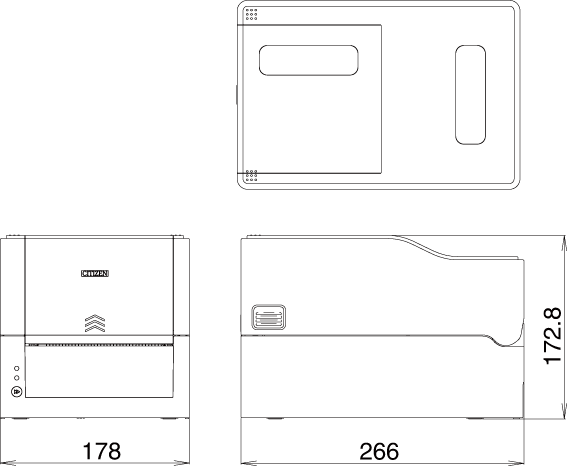
CL-E321X***NS (model with AC adapter storage case)
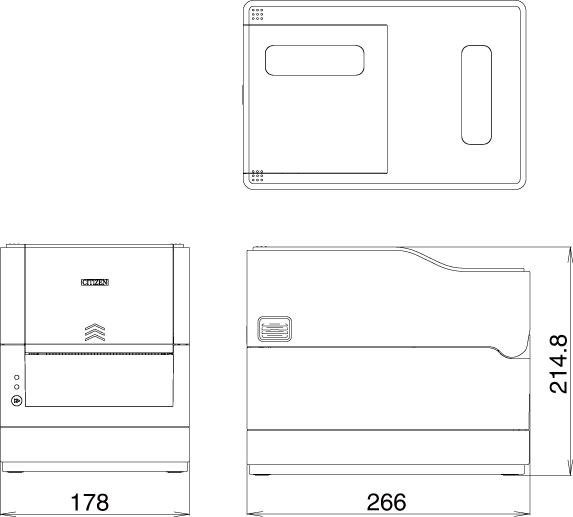
CL-E321X***BC (model with cutter)
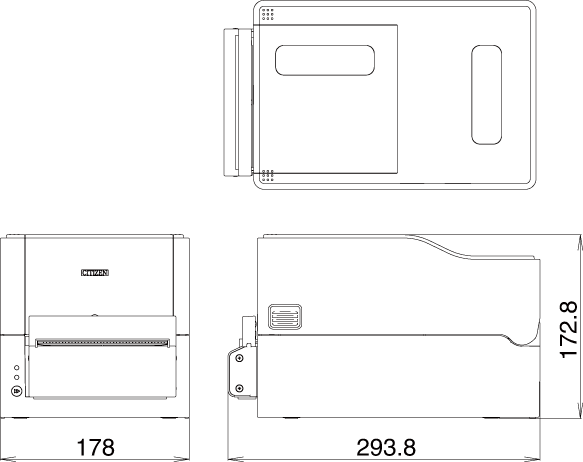
*6 Dimensions are design values. Actual dimensions may vary due to variance in manufacturing
processes.
Usage Conditions
- (1)Safe operating temperature: 0 to 40°C
- (2)Safe printing temperature: 5 to 35°C
- (3)Humidity: 30 to 80% RH (no condensation)
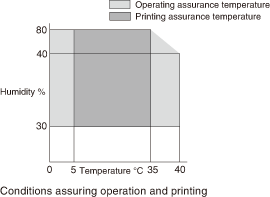
Storage Conditions
- (1)Temperature: -20 to 60°C (excluding record sheet)
- (2)Humidity: 5 to 85% RH (excluding record sheet, no condensation)
*However, for storage at high temperature and humid environments, the combination
of 40°C and 85% RH (no condensation) is taken as the worst value.
Interfaces
USB Interface
Specifications
| Standard |
Compliant with Universal Serial Bus Specification 2.0 |
| Transmission speed |
Supports Full-speed 12 Mbps transfer |
| Receive buffer |
16 kB receive buffer |
| Connector |
USB Type B connector |
Signal Line/Pin Assignment
| Signal code |
Signal |
Pin No. |
Function |
| VBUS |
USB power |
1 |
USB power (+5 V) |
| D- |
Negative signal line |
2 |
Negative signal line |
| D+ |
Positive signal line |
3 |
Positive signal line |
| GND |
GND |
4 |
GND |
Ethernet Interface
Supported Protocols
| Supported Protocols |
ARP, IP, and TCP |
| Transport layer protocols |
TCP and UDP |
| Application layer protocols |
DHCP, HTTP, SNMP, and Raw Socket Port |
Raw Socket Port
Performs bidirectional communication of print data and printer status.
| Port No. |
9100 (user-configurable) |
| Direction of port communication |
Bidirectional |
| Max. socket connections |
8 |
| Printable connections |
1 (other sockets are reserved) |
| Timeout |
Default: 60 seconds
Configurable between 0 and 300 seconds.
Value of 0 disables timeouts. |
HTTP Server
The Web monitoring function can be used to configure printer and network settings.
Refer to the pages describing the Web monitor for more information.
| Port No. |
80 |
| Max. simultaneous connections |
4 |
| HTTP version |
HTTP/1.1 |
DHCP
Automatically retrieves IP address information from a DHCP server within 60 seconds
after the power is turned on.
If IP address information cannot be retrieved automatically, a fixed IP address (default
is 169.254.1.10) is applied.
SNMP Agent
| SNMP Version |
SNMPv2 (Trap function not supported) |
| Port No. |
161 |
| Supported MIBs |
HOST-RESOURCES-MIB and Citizen-MIB (Private) |
| Community name |
public |
Connector Connections
| Pin No. |
Signal |
Function |
| 1 |
TX+ |
Transmit (positive) |
| 2 |
TX- |
Transmit (negative) |
| 3 |
RX+ |
Receive (positive) |
| 4 |
N.C. |
- |
| 5 |
N.C. |
- |
| 6 |
RX- |
Receive (negative) |
| 7 |
N.C. |
- |
| 8 |
N.C. |
- |
Compatible connectors
Printer: RJ-45 connector
LED operation
The following table describes port LED operation.

- 1.Network communication speed indicator
| Communication speed |
LED (Green) |
| 100 Mbps |
On |
| 10 Mbps/disconnected |
Flashes |
- 2.Network status indicator
| Status |
LED (amber) |
| Connecting |
On |
| Disconnected |
Off |
| Exchanging data |
Flashes |
Serial Interface
Interface Specifications
| Transfer method |
Start-stop synchronization method, full-duplex communication |
| Signal level |
RS-232C |
| Baud rates |
2400, 4800, 9600, 19200, 38400, 57600, and 115200 bps |
| Data length |
7 bits or 8 bits |
| Stop bits |
1 bits or 2 bits |
| Parity |
Even, odd, or none |
| Interface |
9-pin D-SUB female connector |
Signal Line/Pin Assignment
| Signal code |
Signal |
Pin No. |
Function |
| INIT |
Reset |
1 |
Reset printer signal line |
| RXD |
Receive data |
2 |
Signal line used by printer to receive data from external devices |
| TXD |
Transmit data |
3 |
Signal line used by printer to send data to external devices |
| DTR |
Data terminal ready |
4 |
Signal line used by printer to notify external devices that printer is ready to communicate |
| SGND |
Signal line ground |
5 |
Signal line ground reference |
| DSR |
Data set ready |
6 |
Signal line used by external devices to notify printer that they are ready to communicate |
| RTS |
Request to send |
7 |
Signal line used by printer to notify external devices that the printer is read to
receive data
|
| CTS |
Clear to send |
8 |
Signal line used by external devices to notify printer that they are ready to receive
data
|
| VCC |
+5 V |
9 |
(Factory use only) |
XON / XOFF Protocol
- a Conditions for XON code output
- Communication is possible after the power is turned on.
- Scenario in which the receive buffer has less than 128 bytes available causing output
of the XOFF code followed by the receive buffer then having at least 1,024 bytes available.
- b Conditions for XOFF code output
- Scenario in which the receive buffer has less than 128 bytes available.
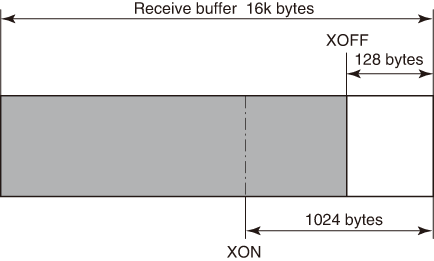
DTR Protocol
- a Conditions when DTR signal state changes to Ready (High)
- Scenario in which the receive buffer has at least 128 bytes available.
- Note that once the receive buffer has less than 1,024 bytes available causing the
DTR signal to change to the Busy (Low) state, the DTR signal state remains in the
Busy (Low) state until the receive buffer has at least 1,024 bytes available.
- b Conditions when DTR signal state changes to Busy (Low)
- Scenario in which the receive buffer has less than 128 bytes available.















 WARNING
WARNING


